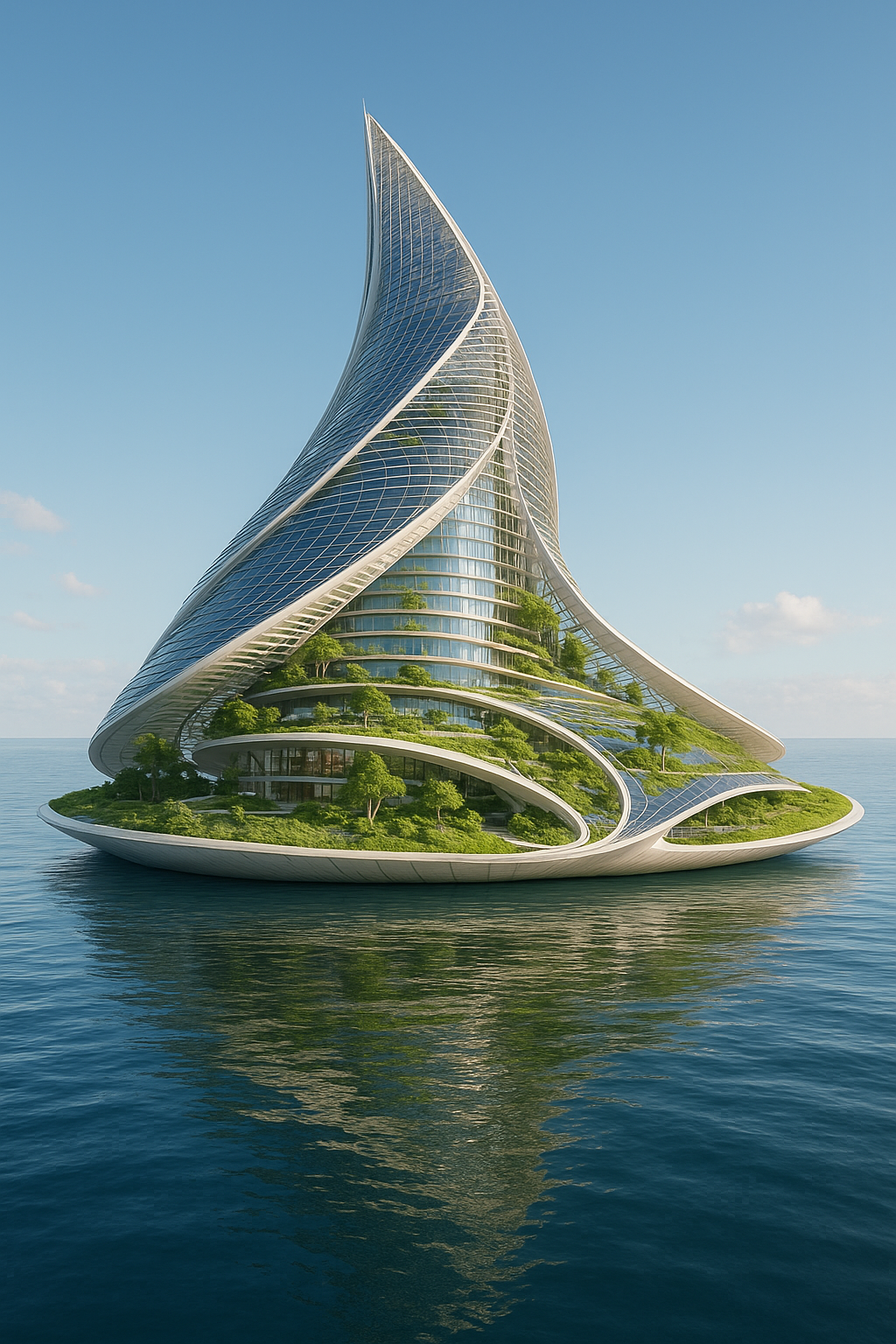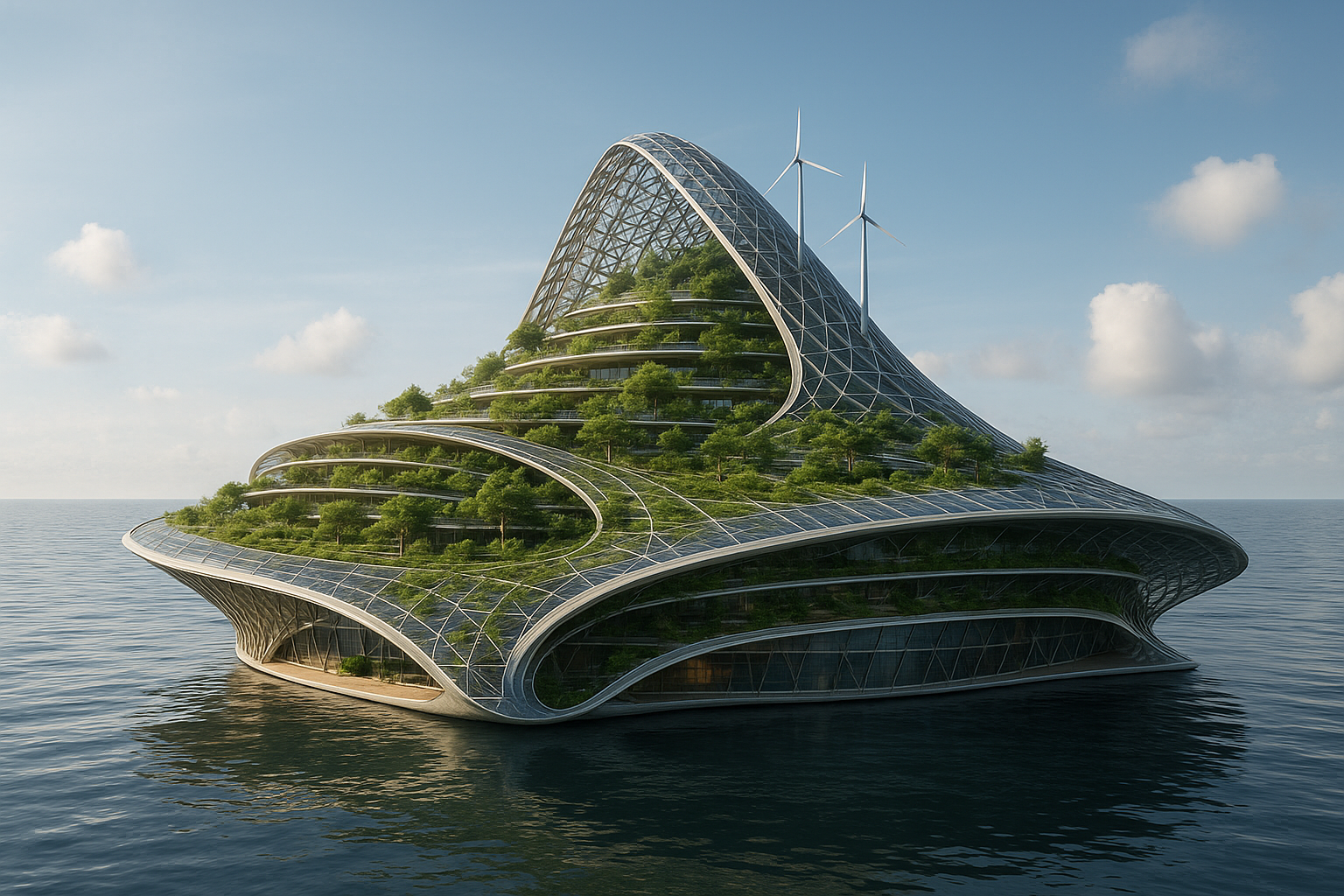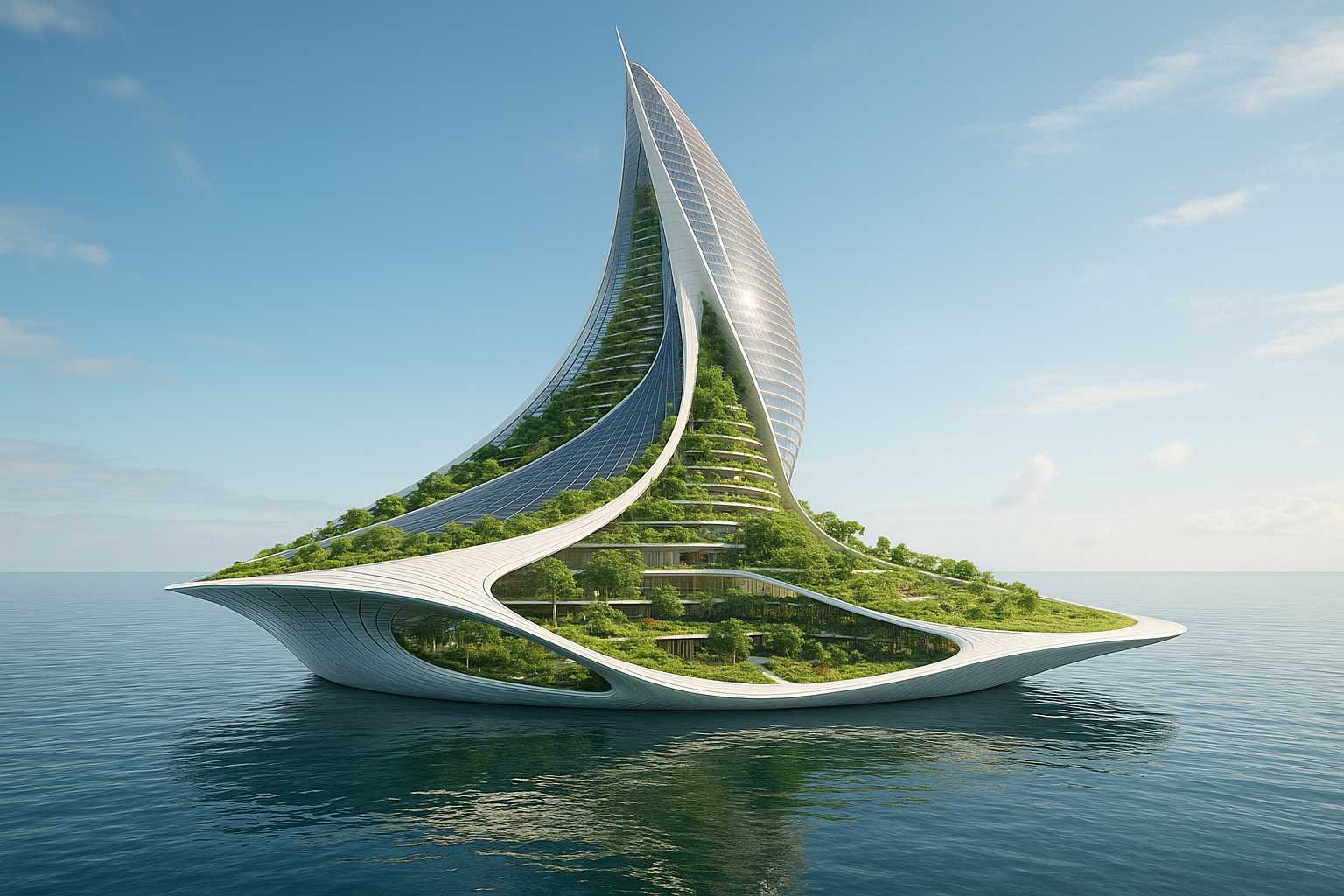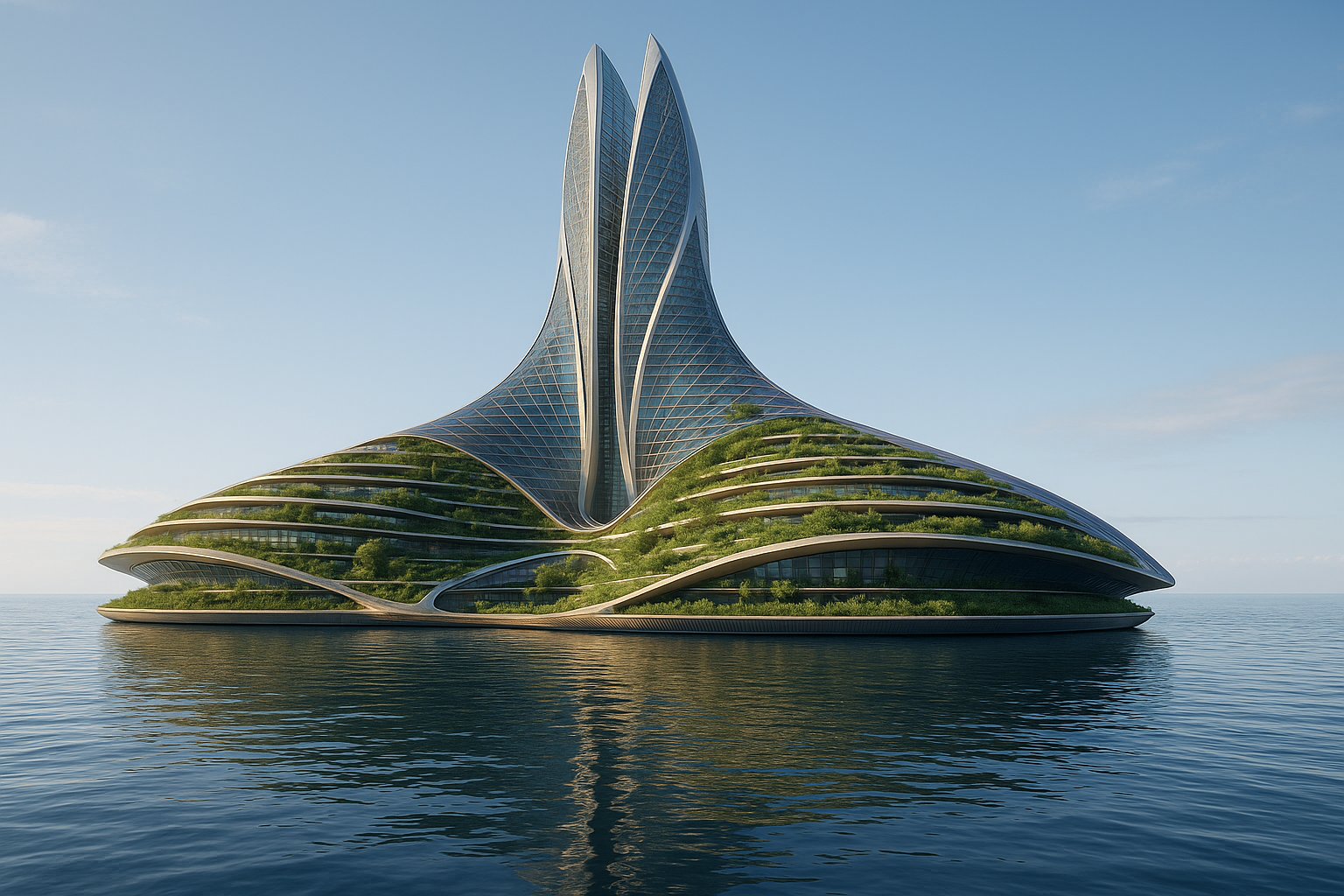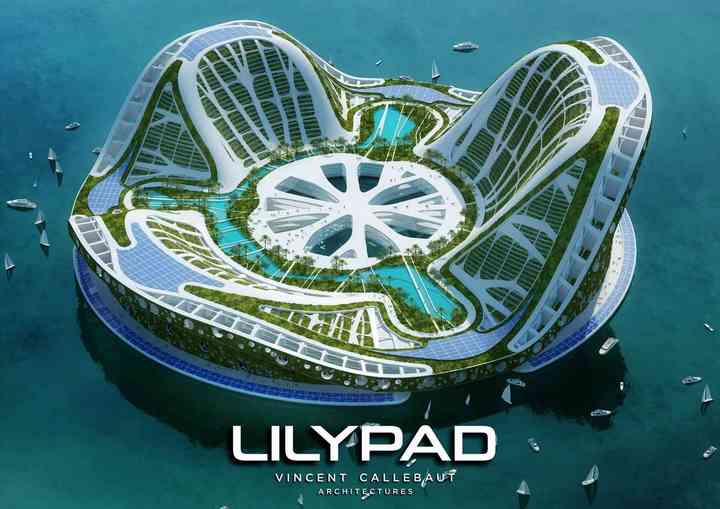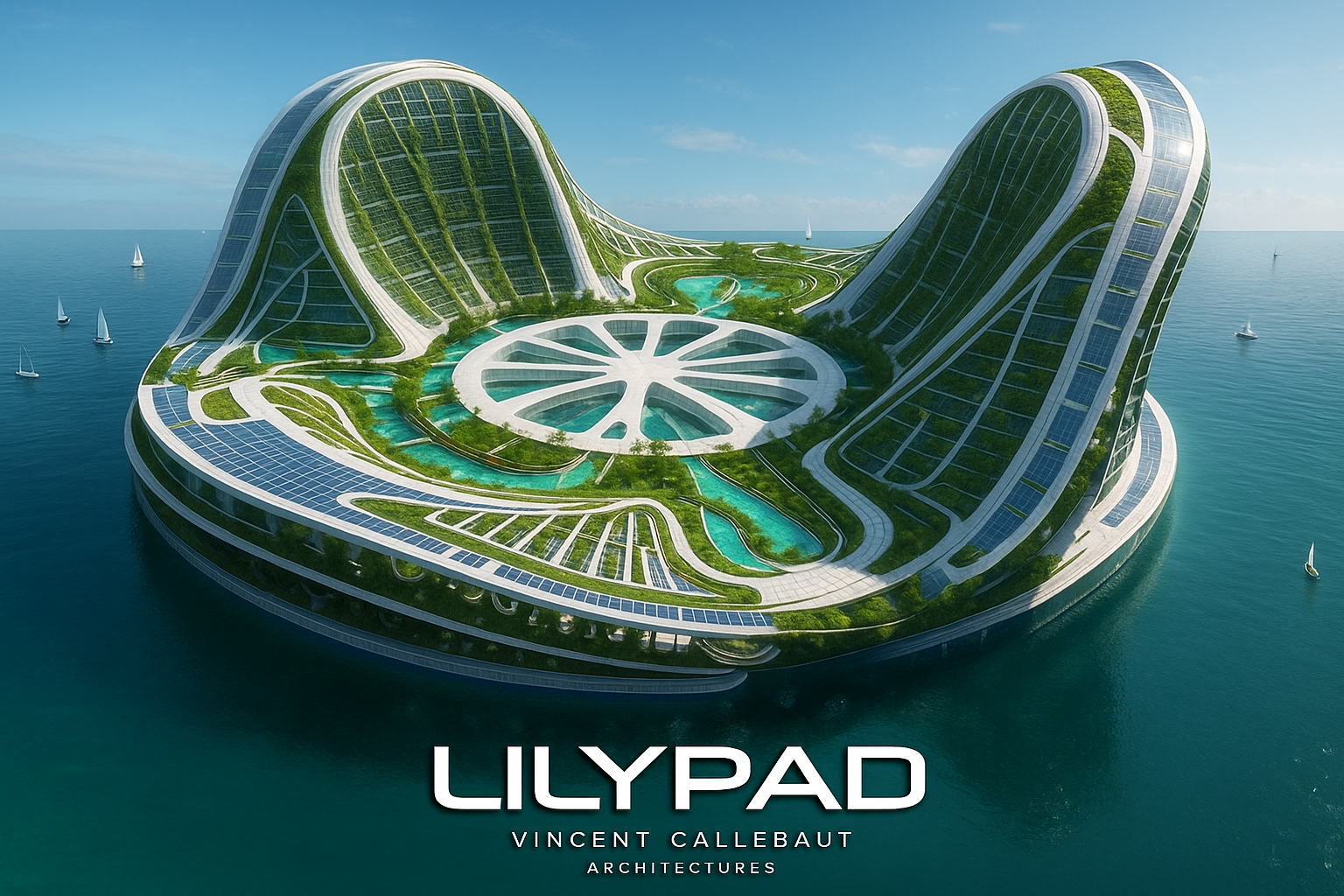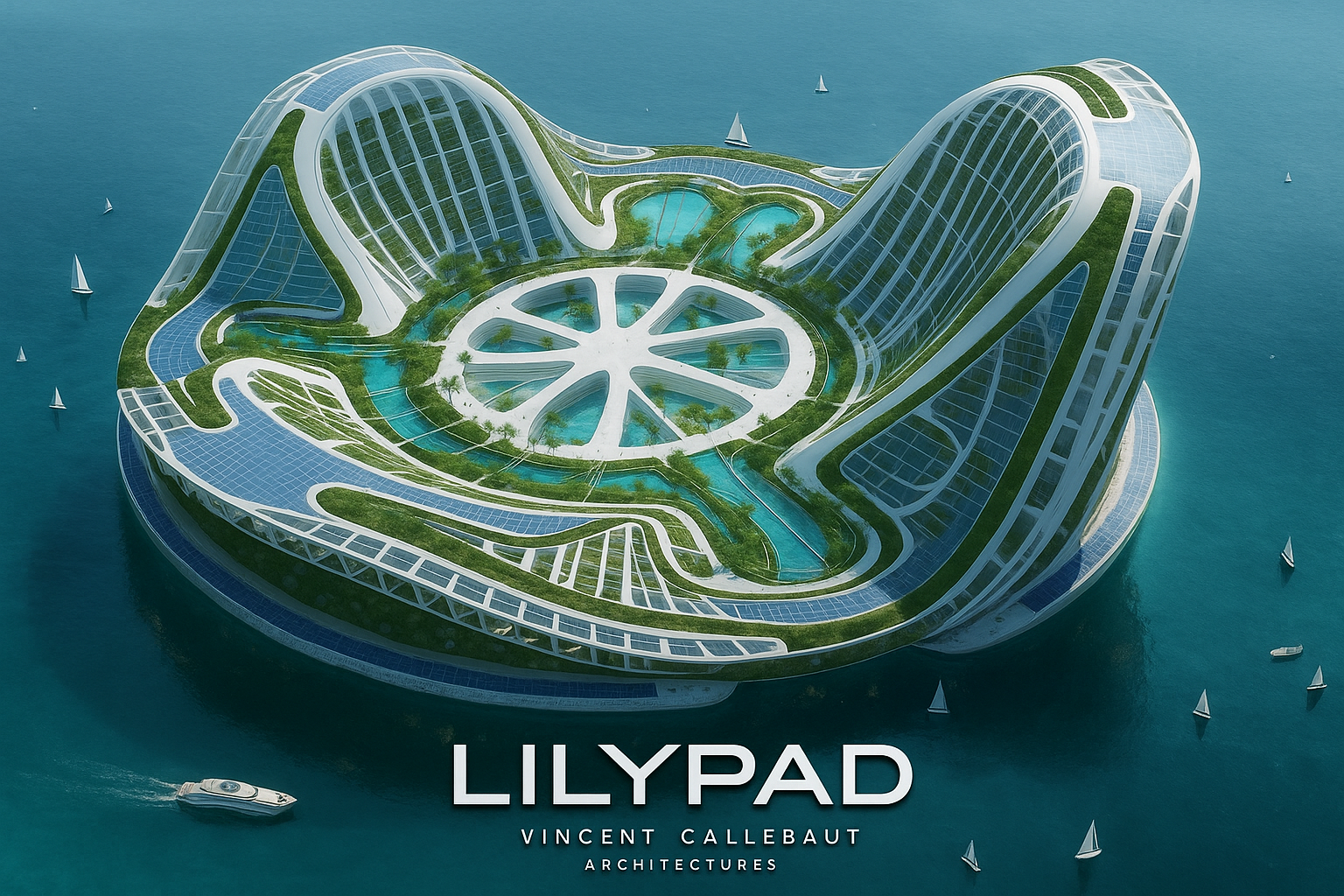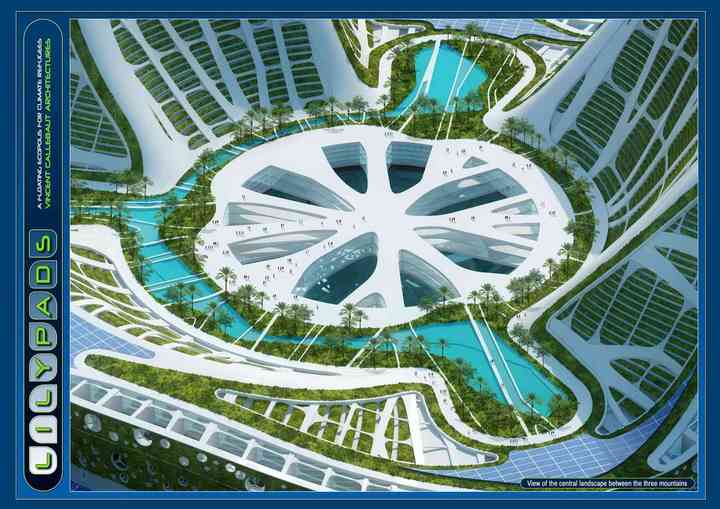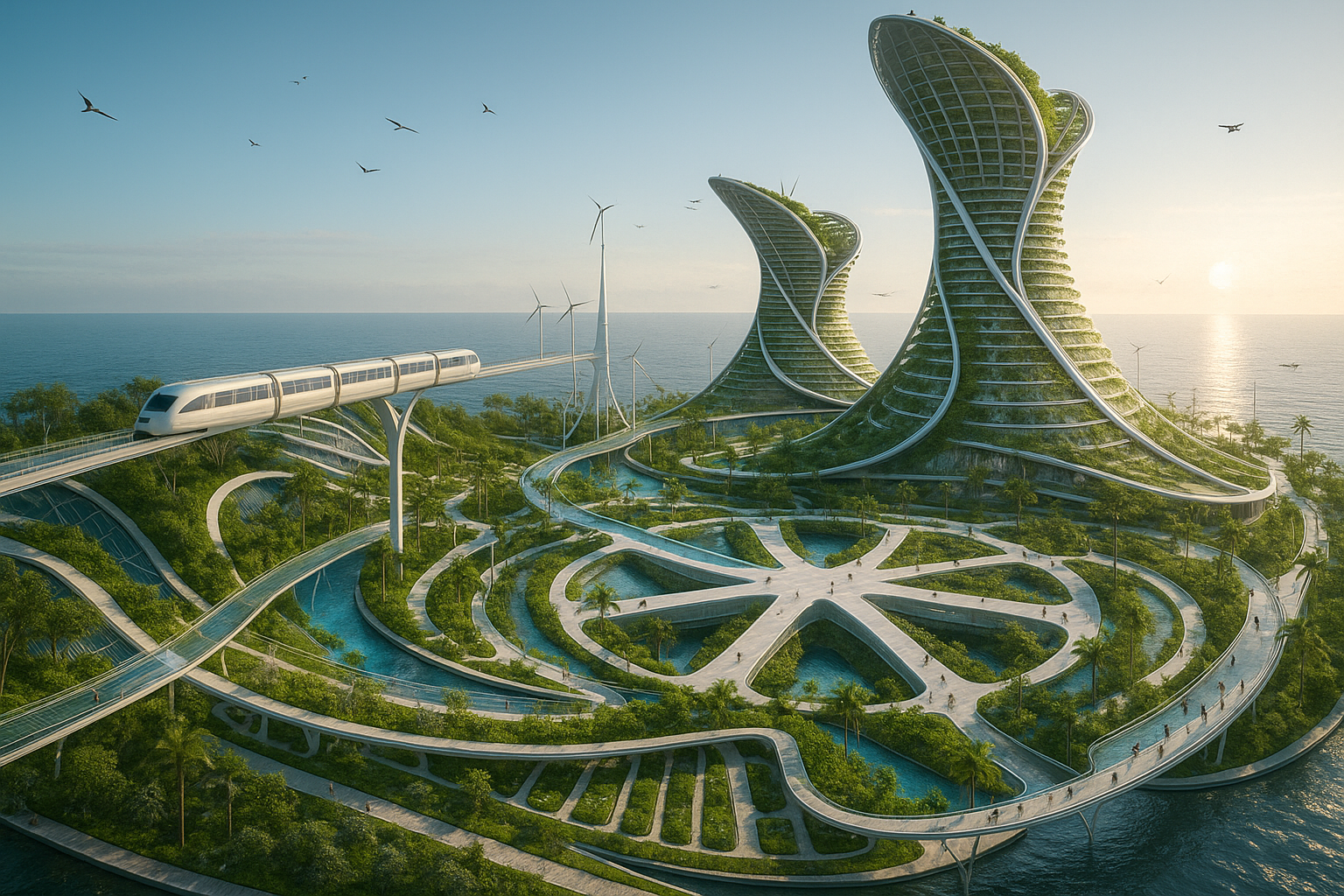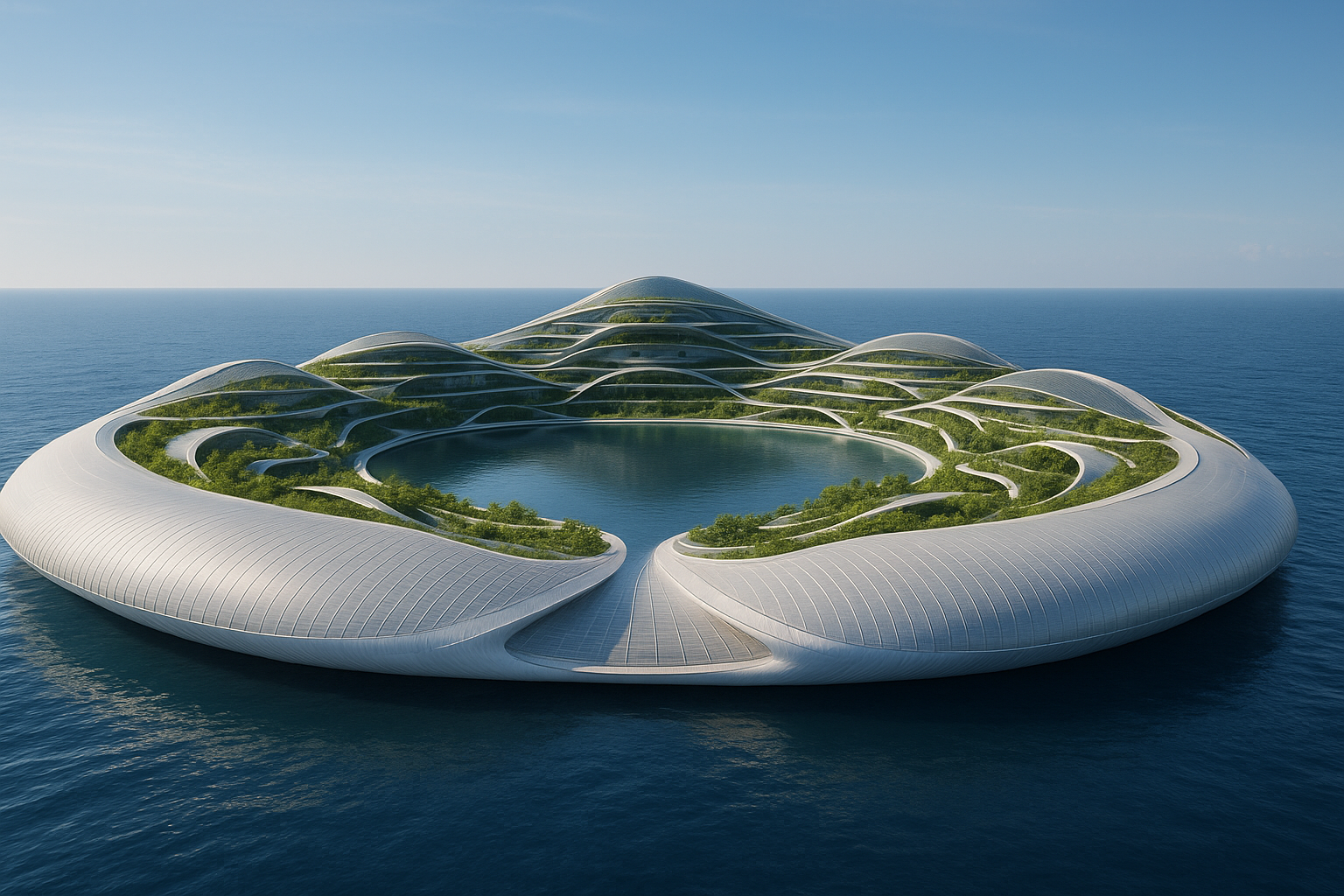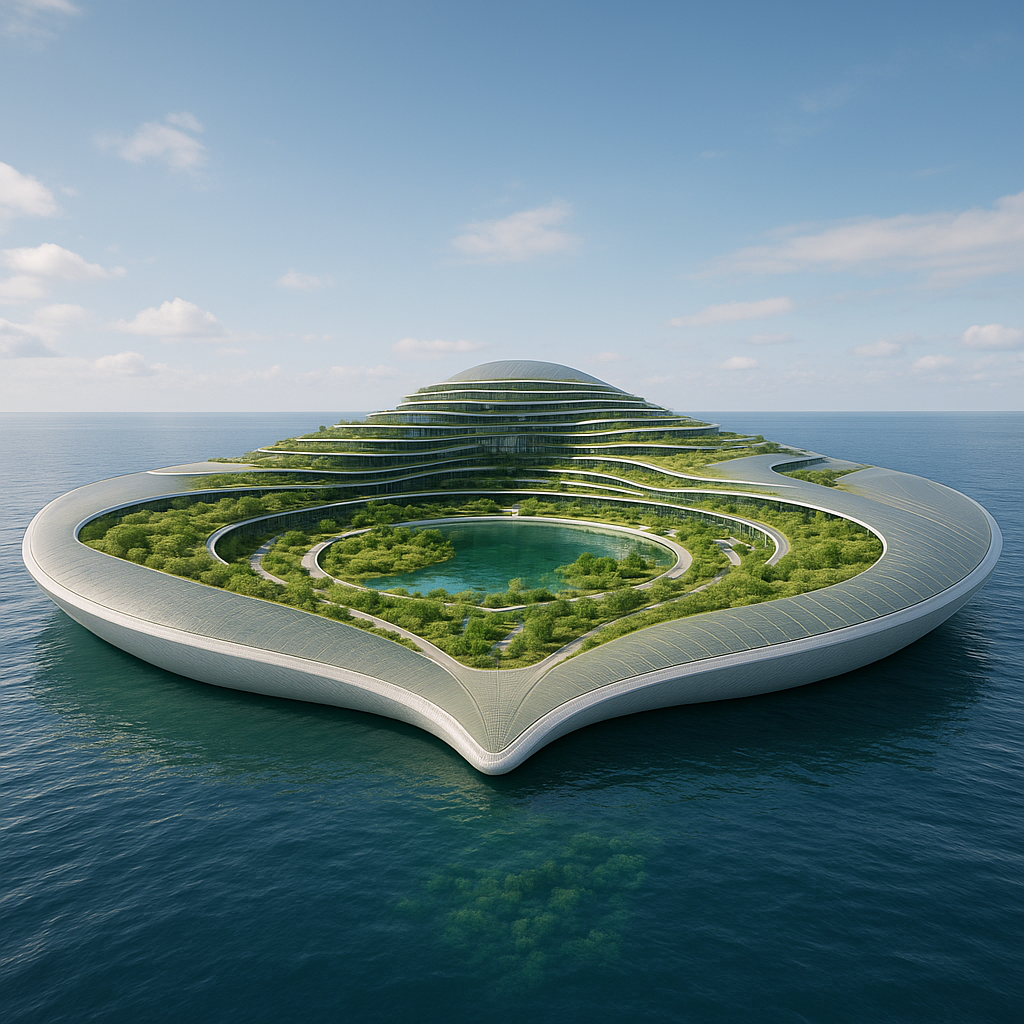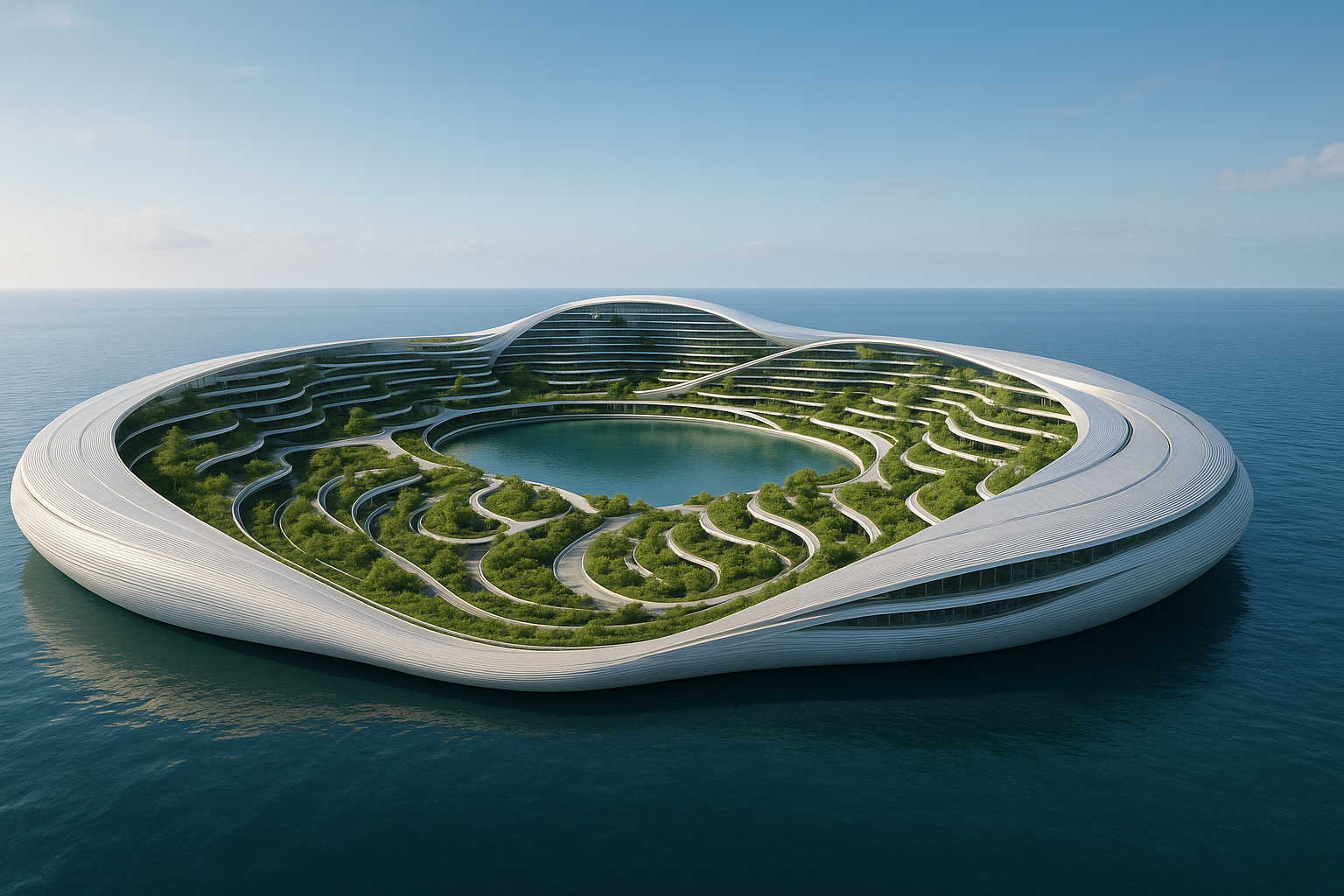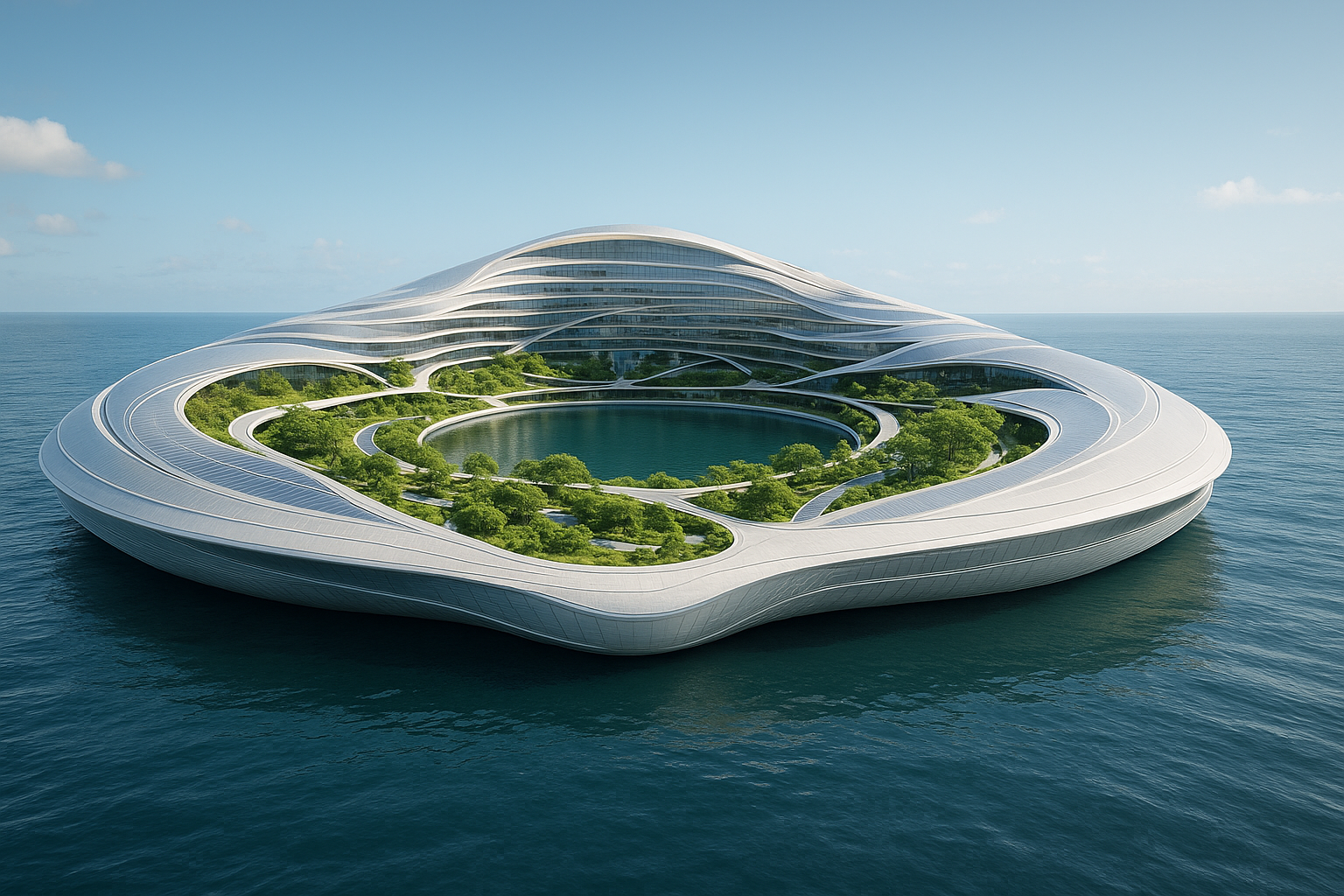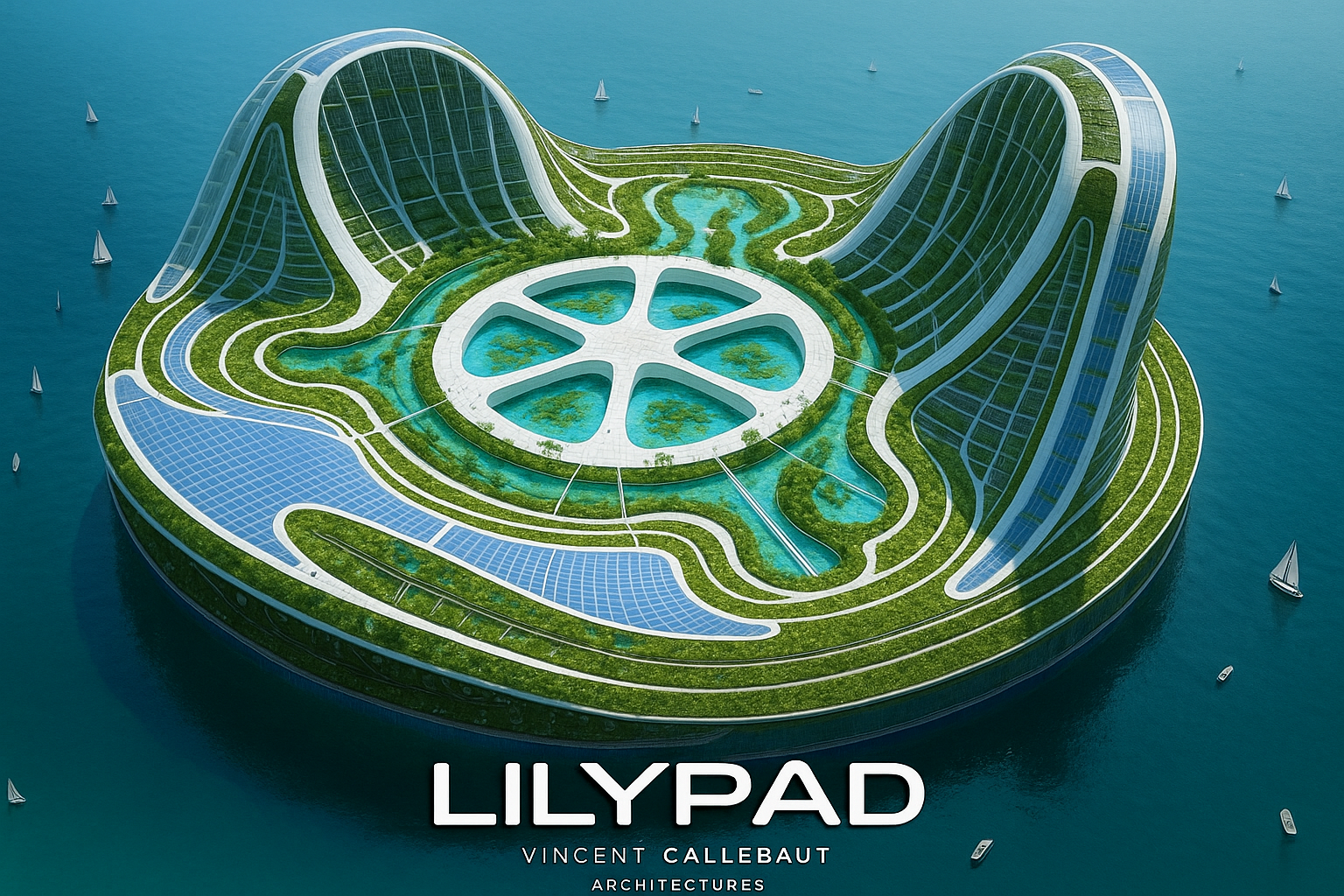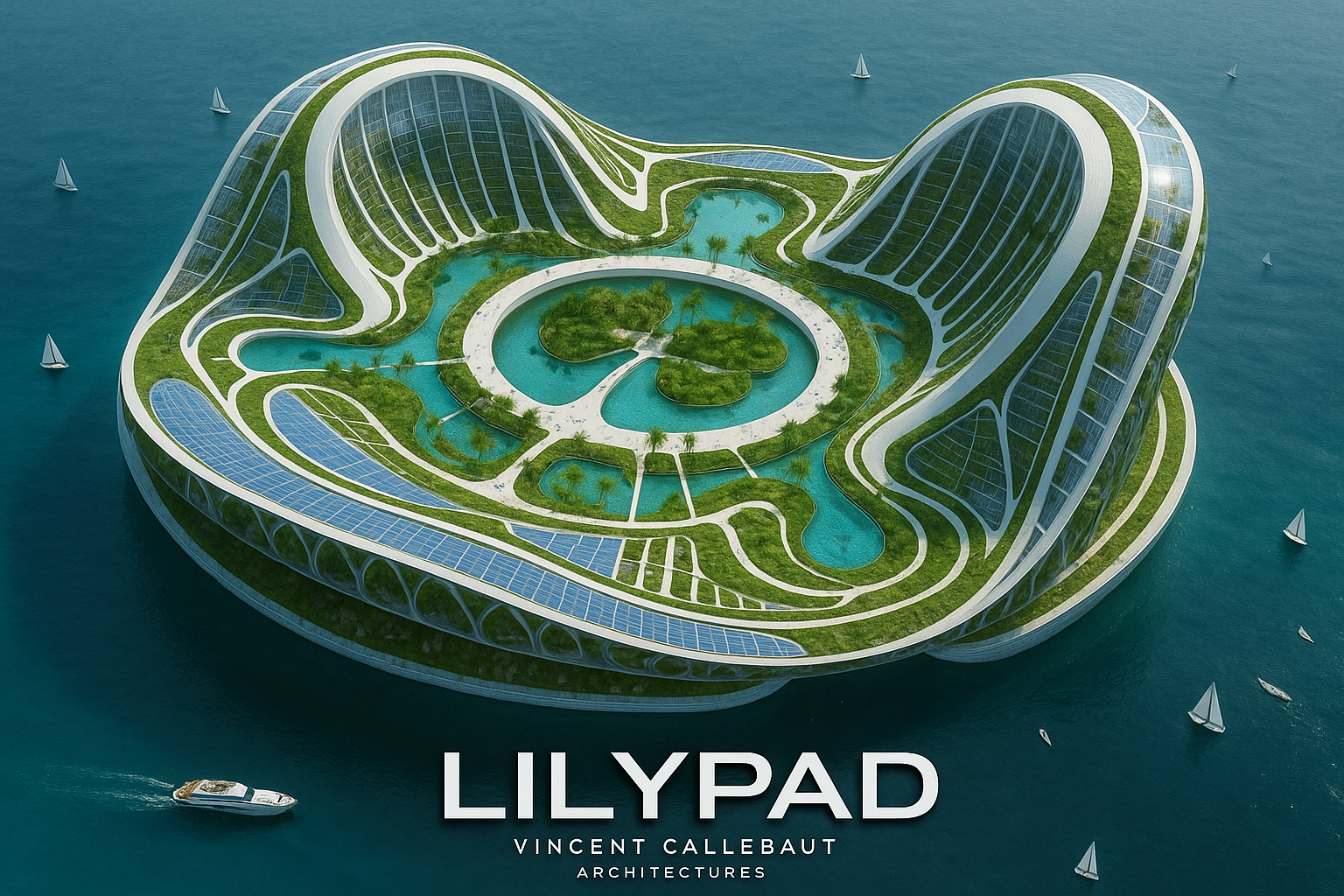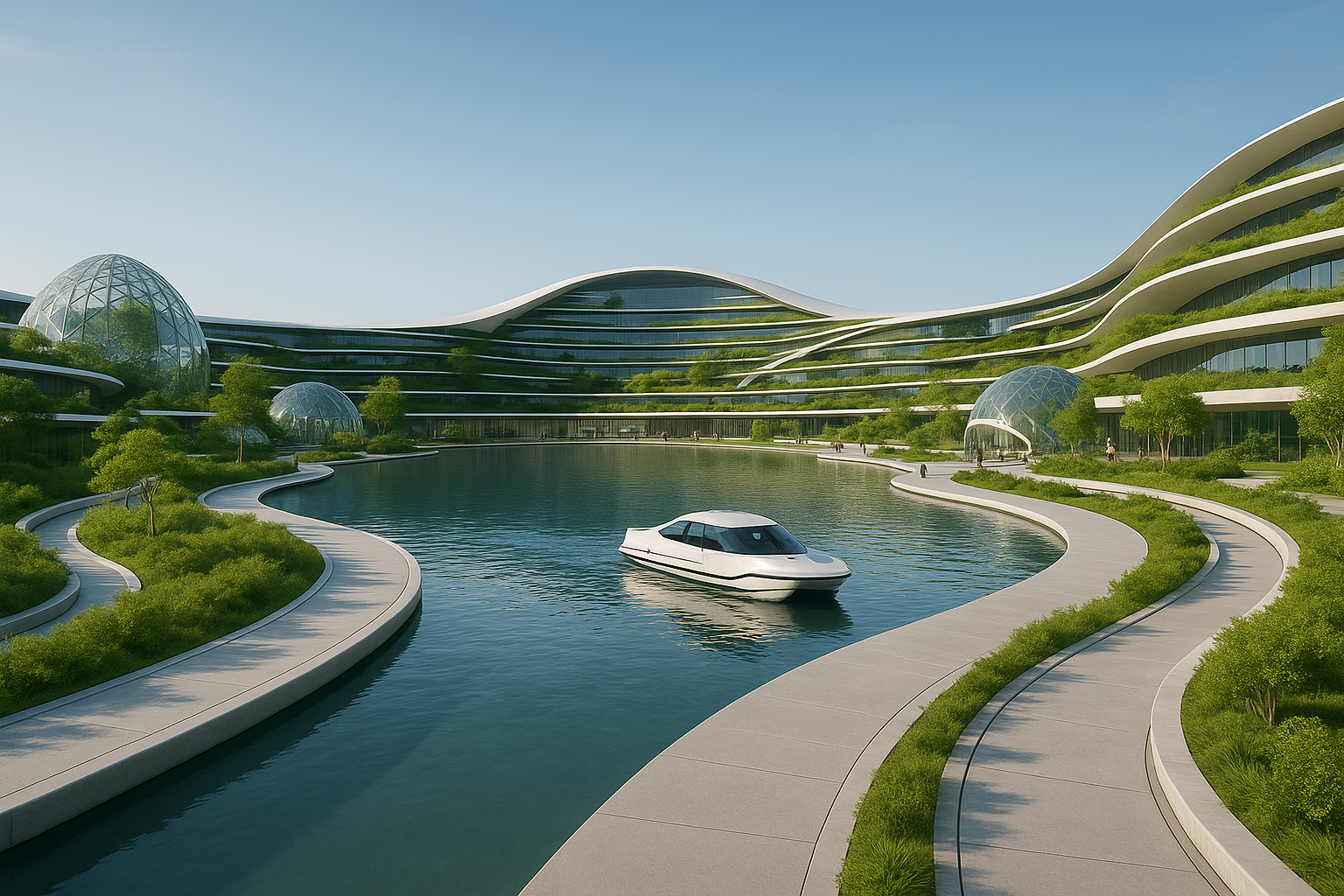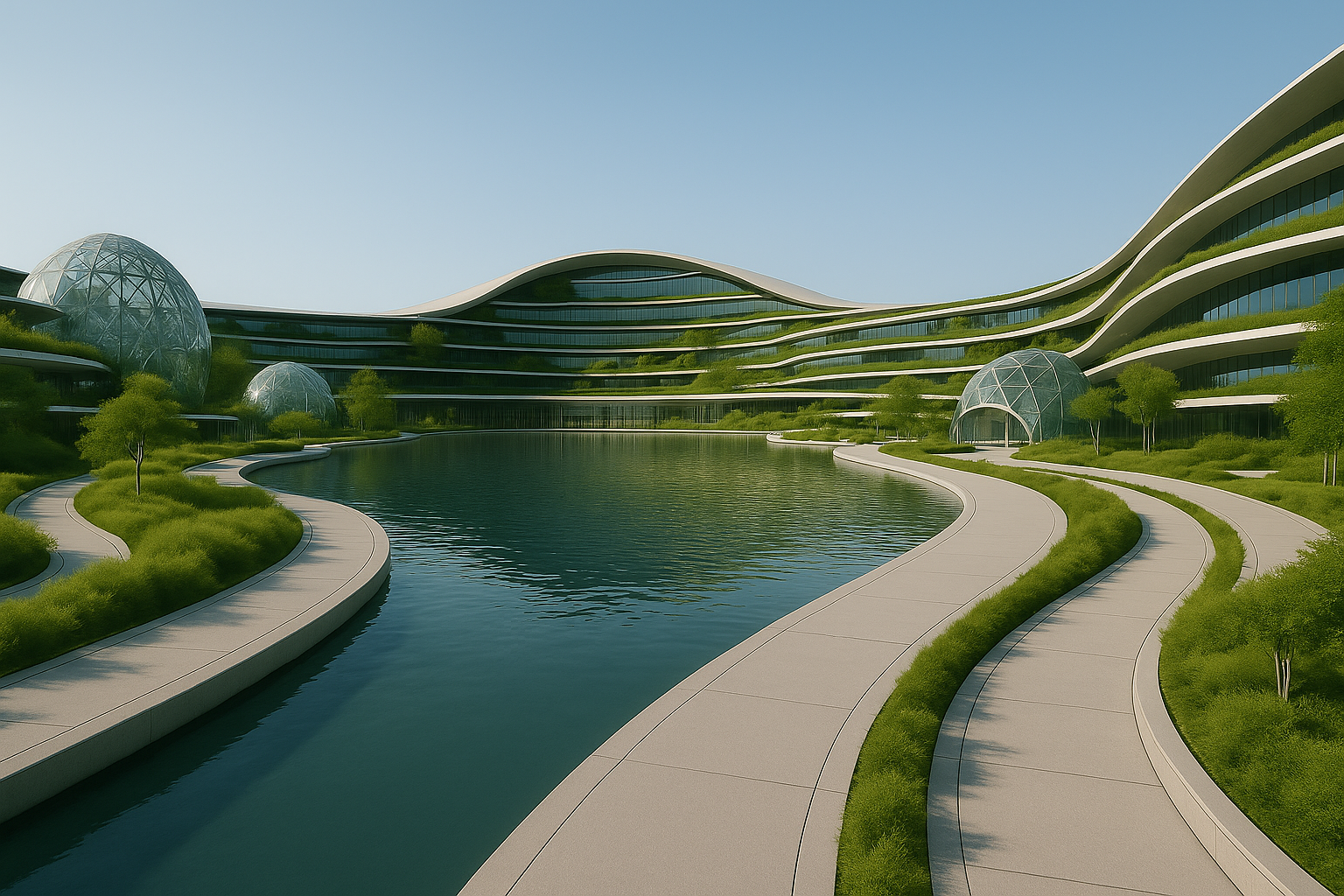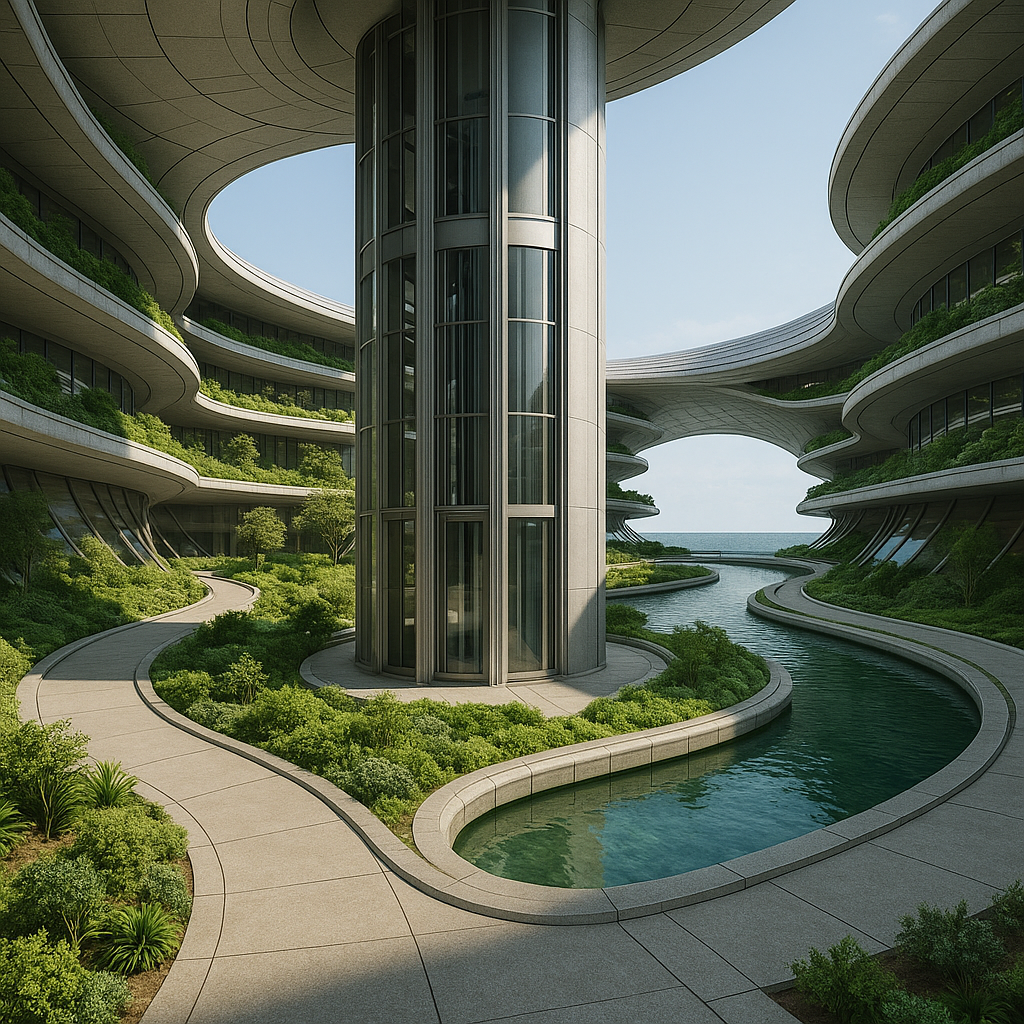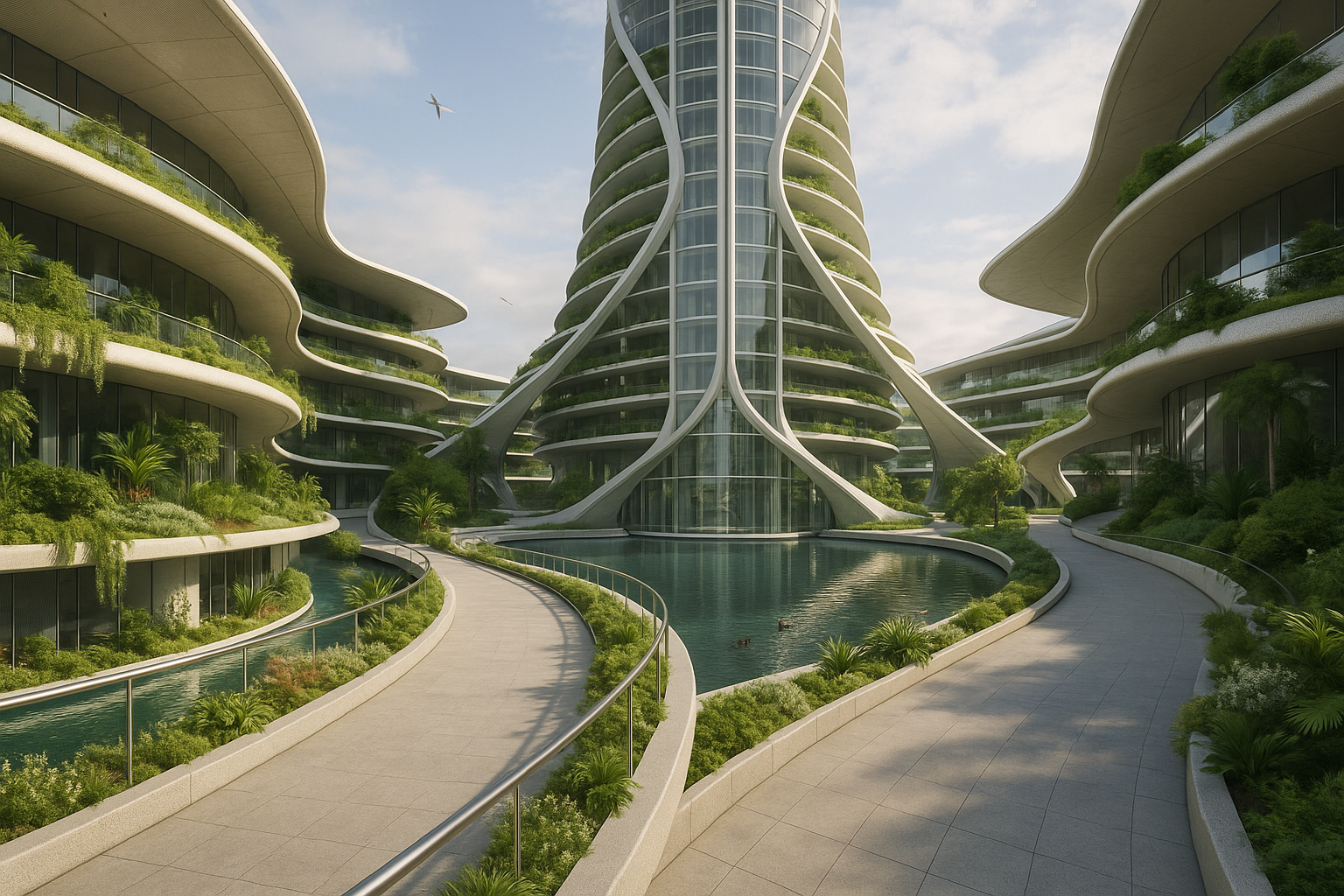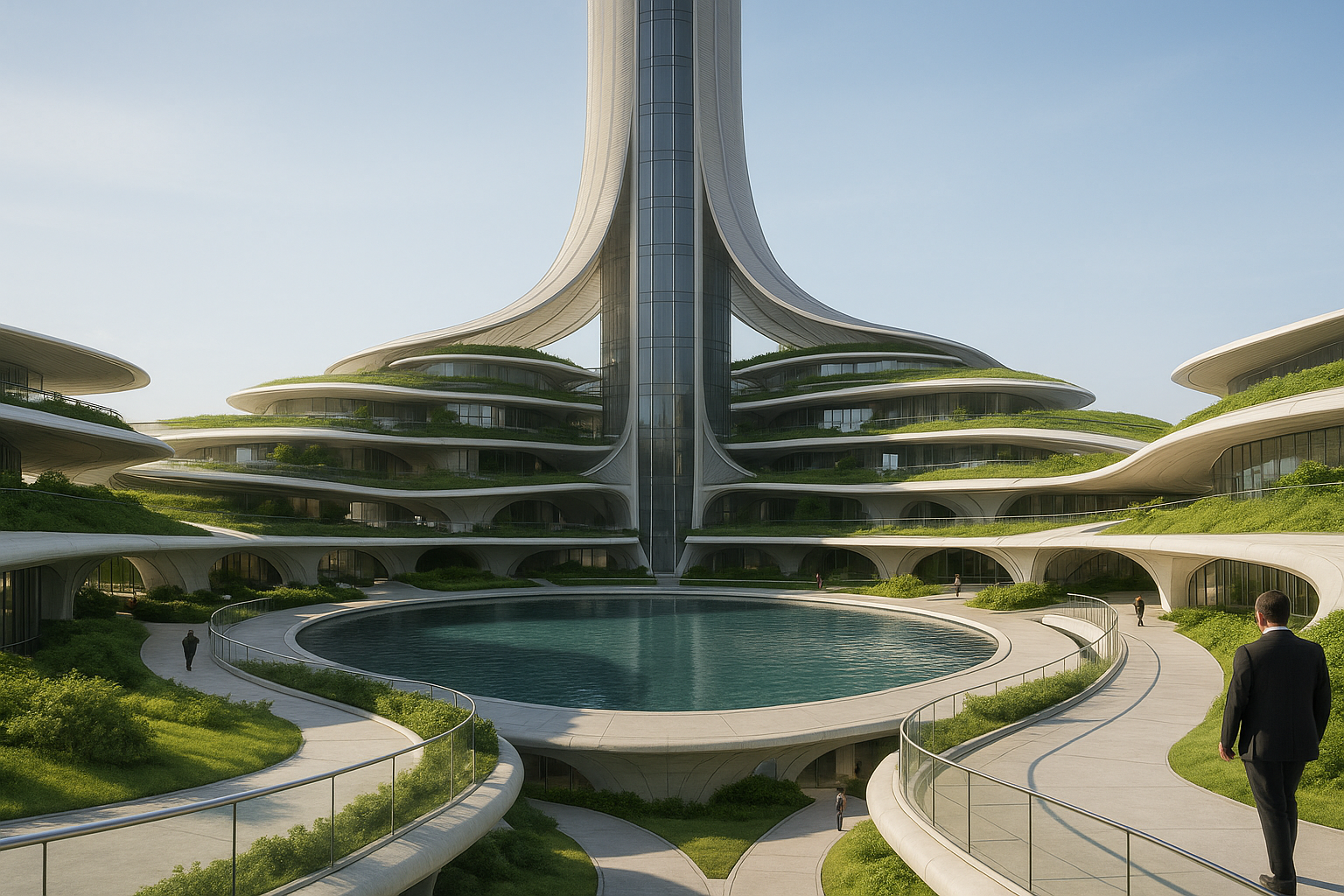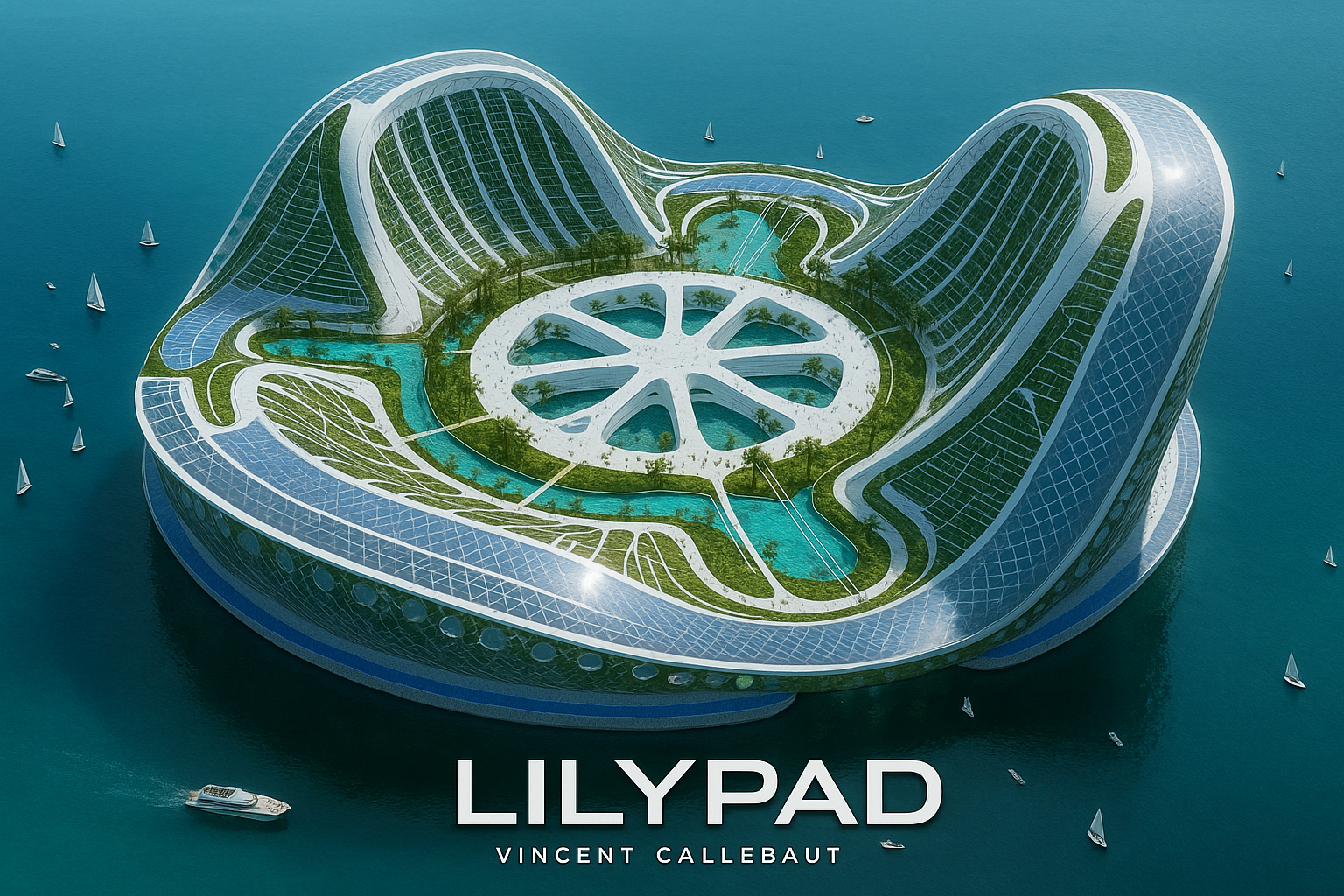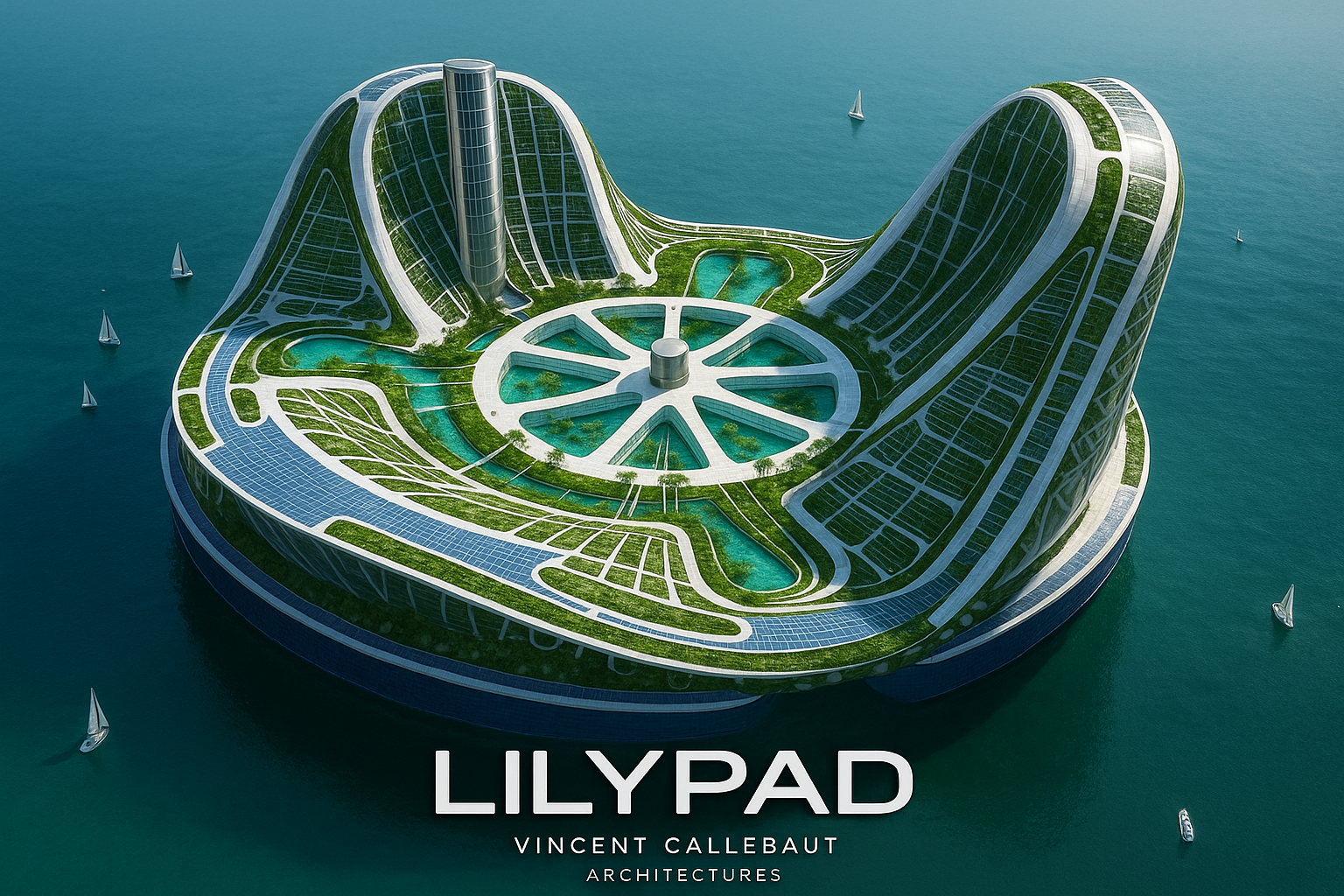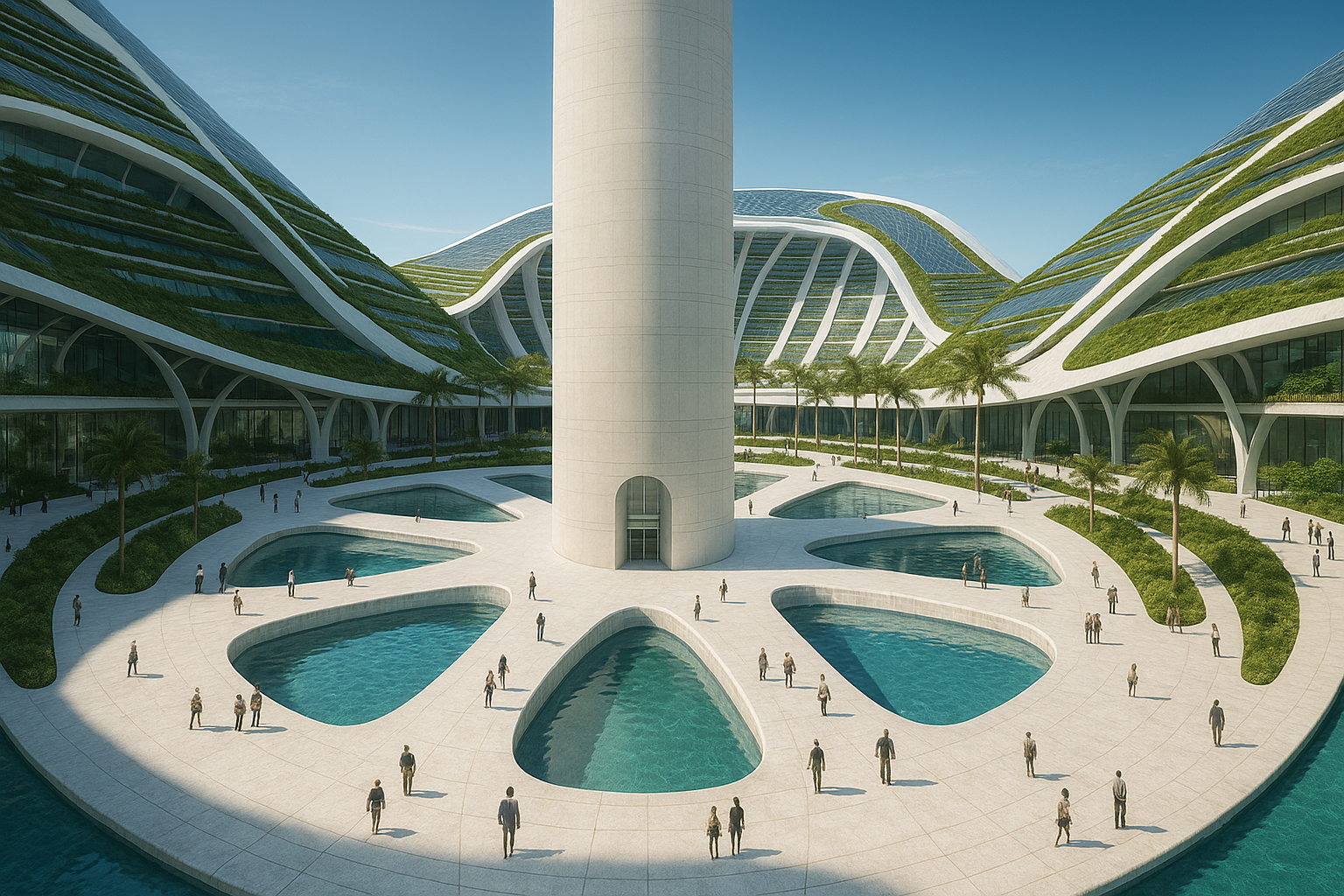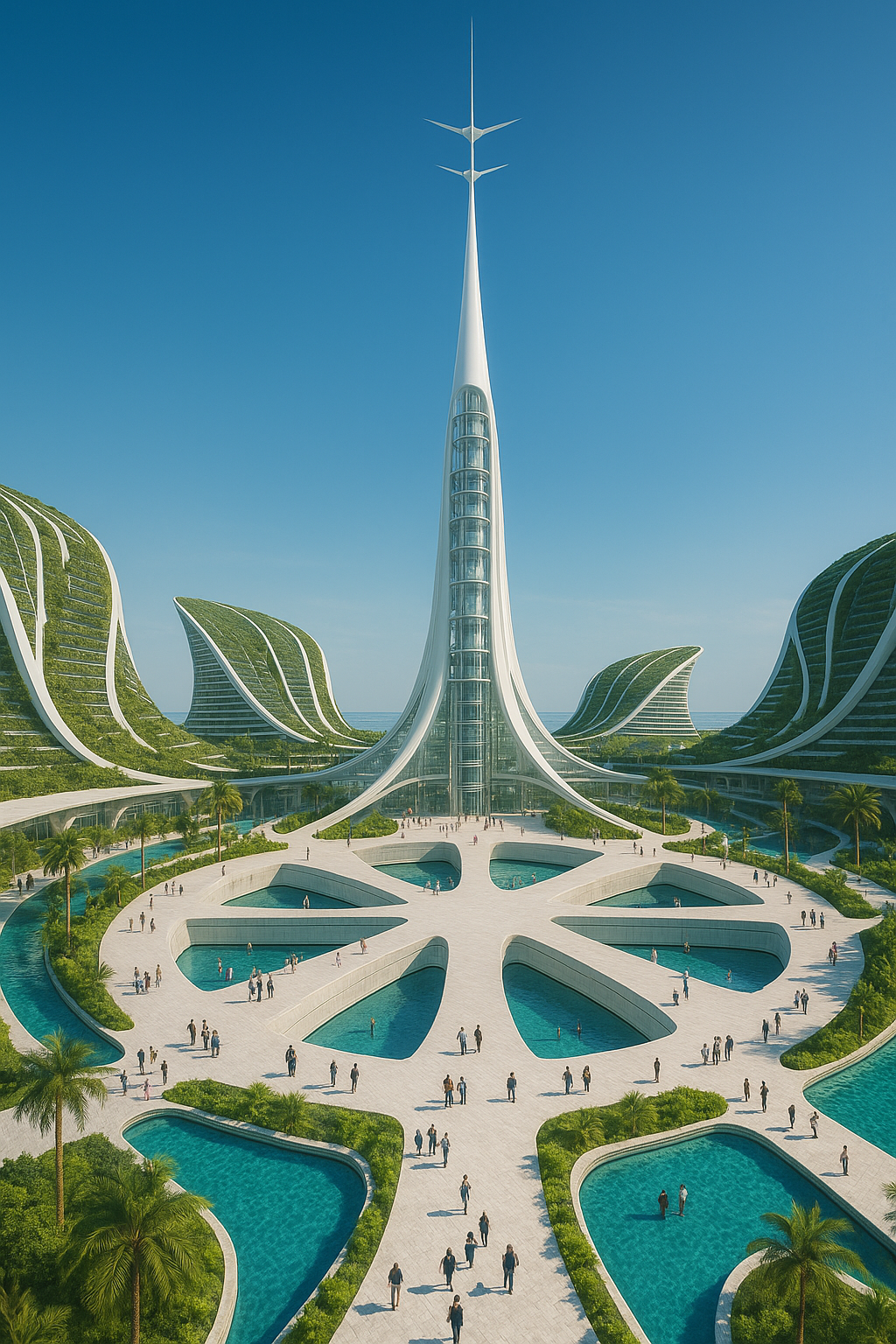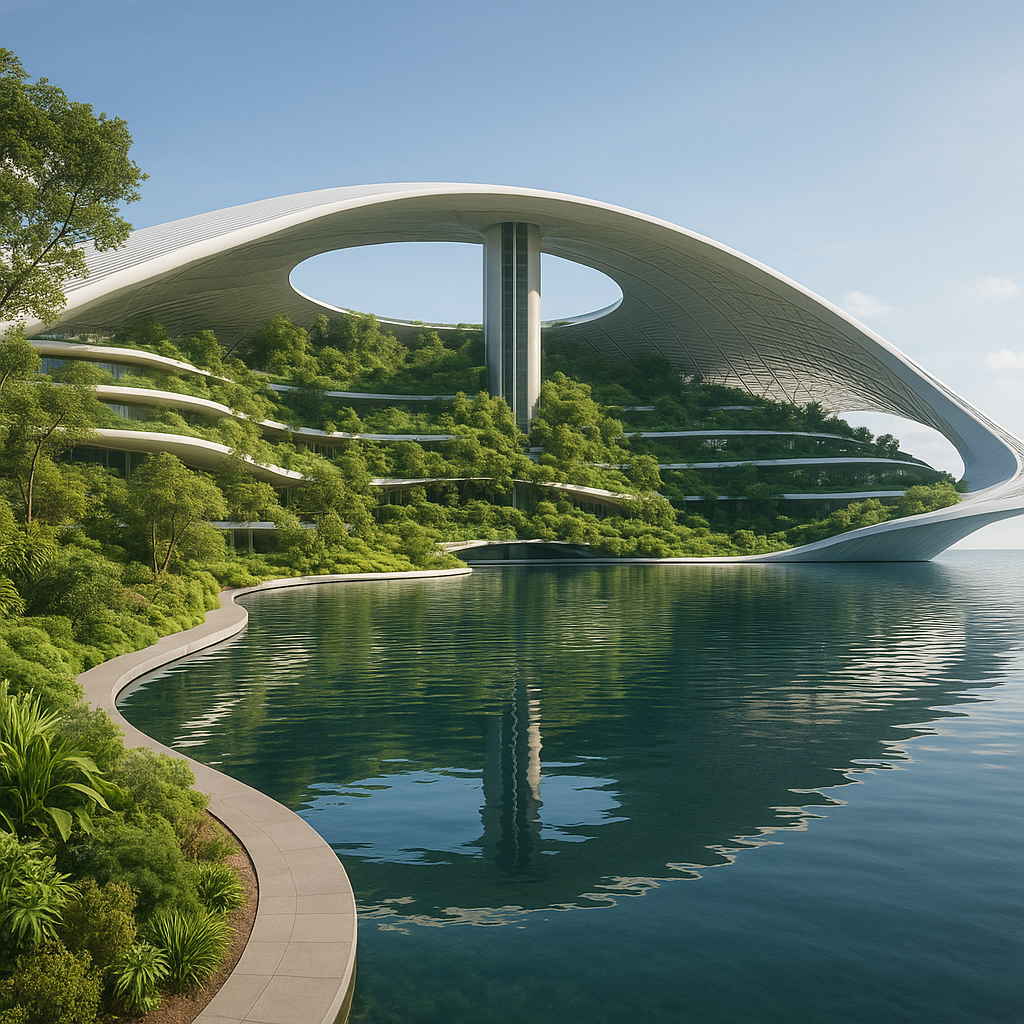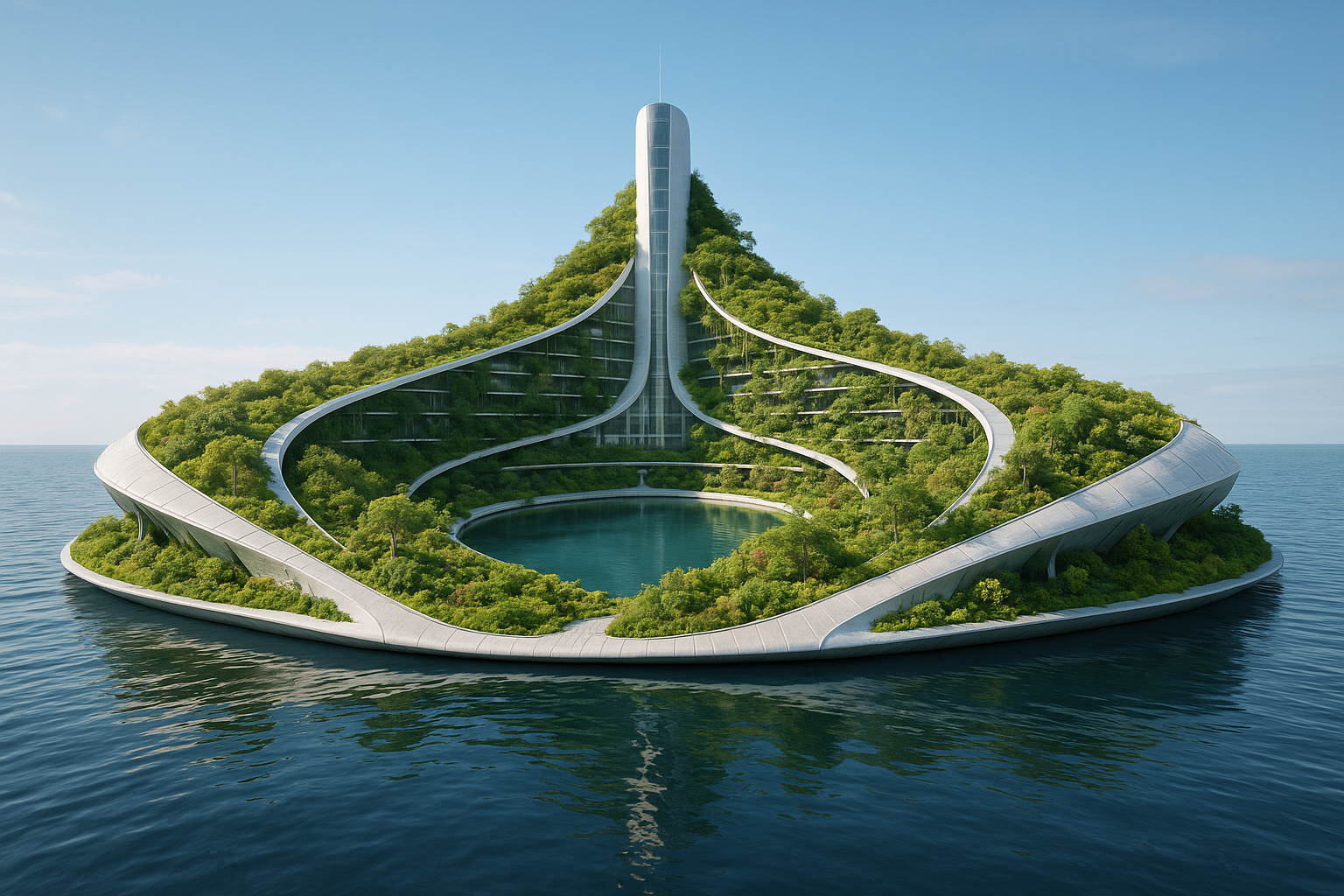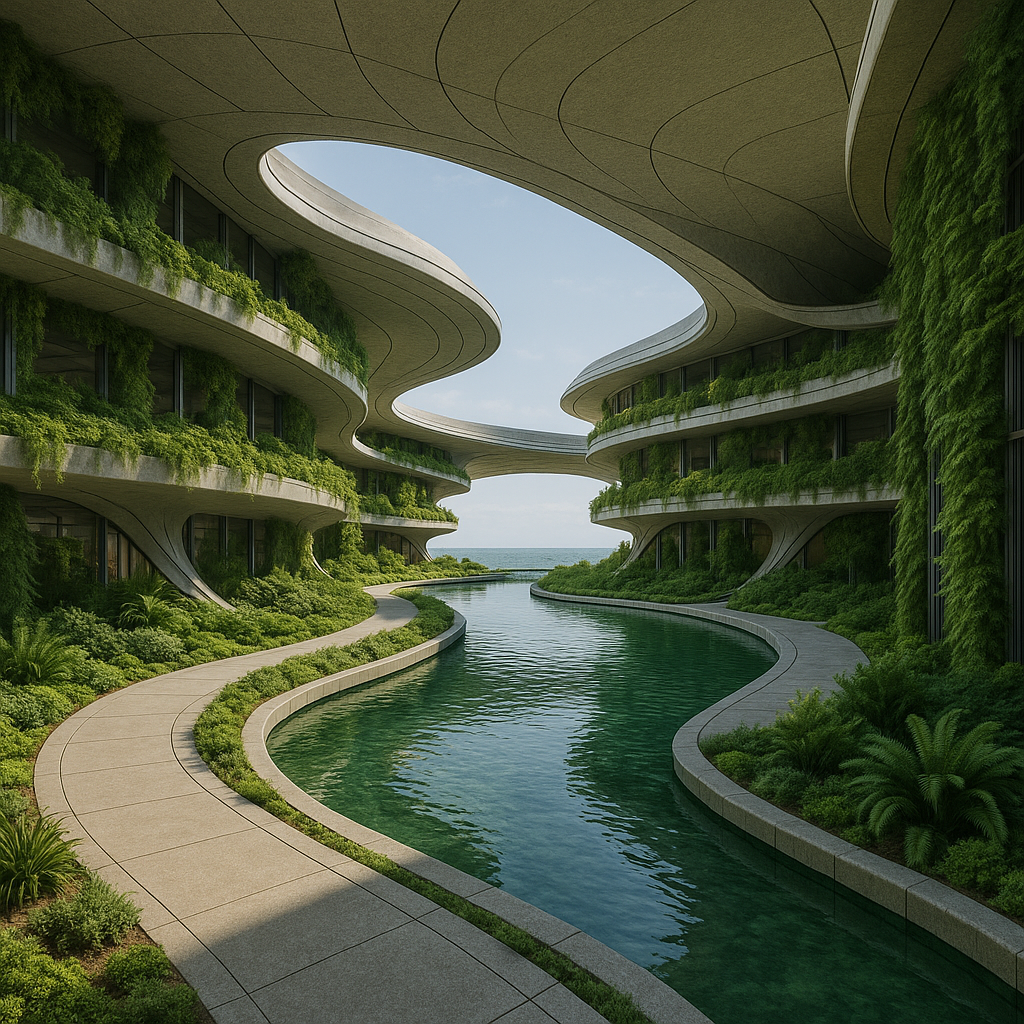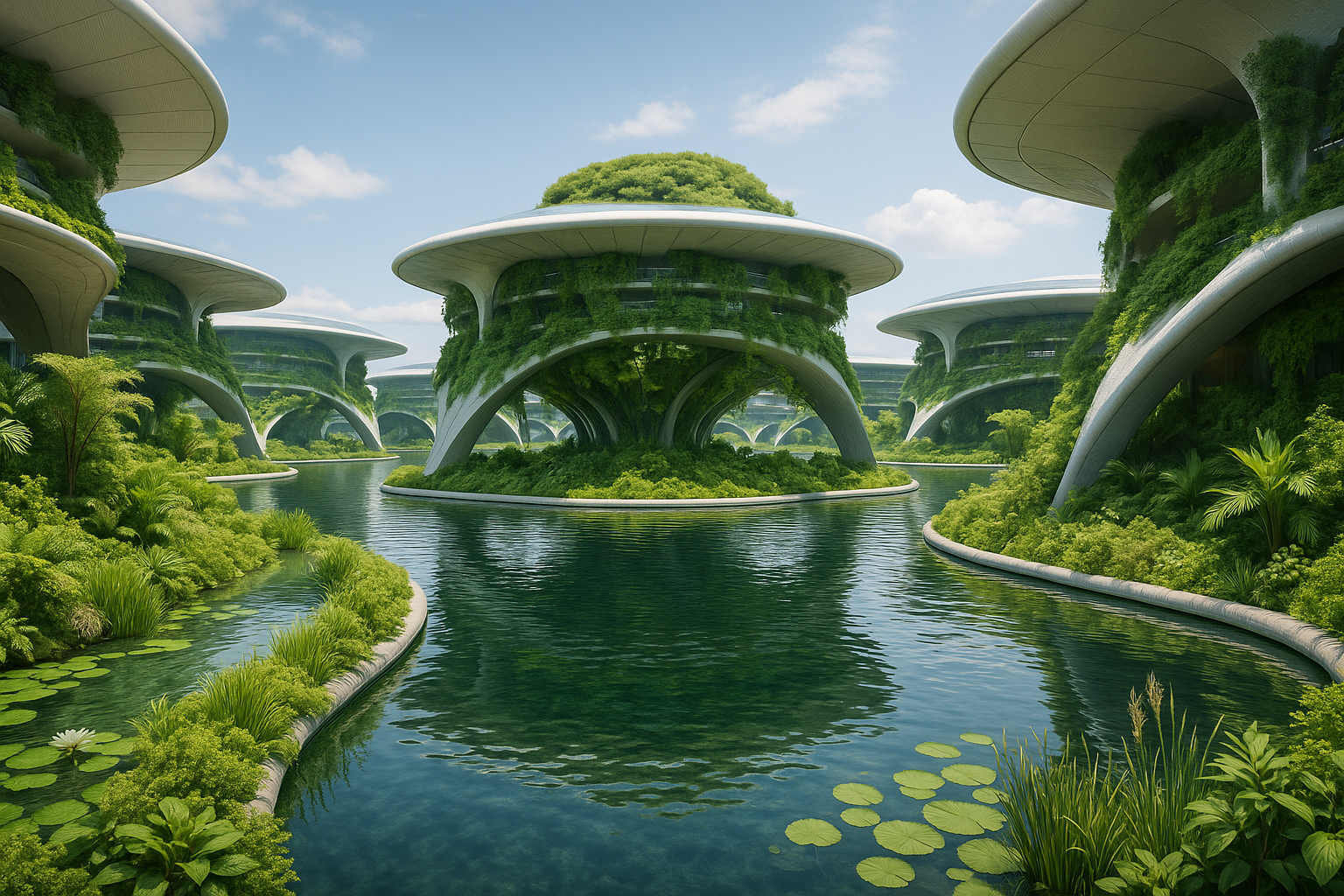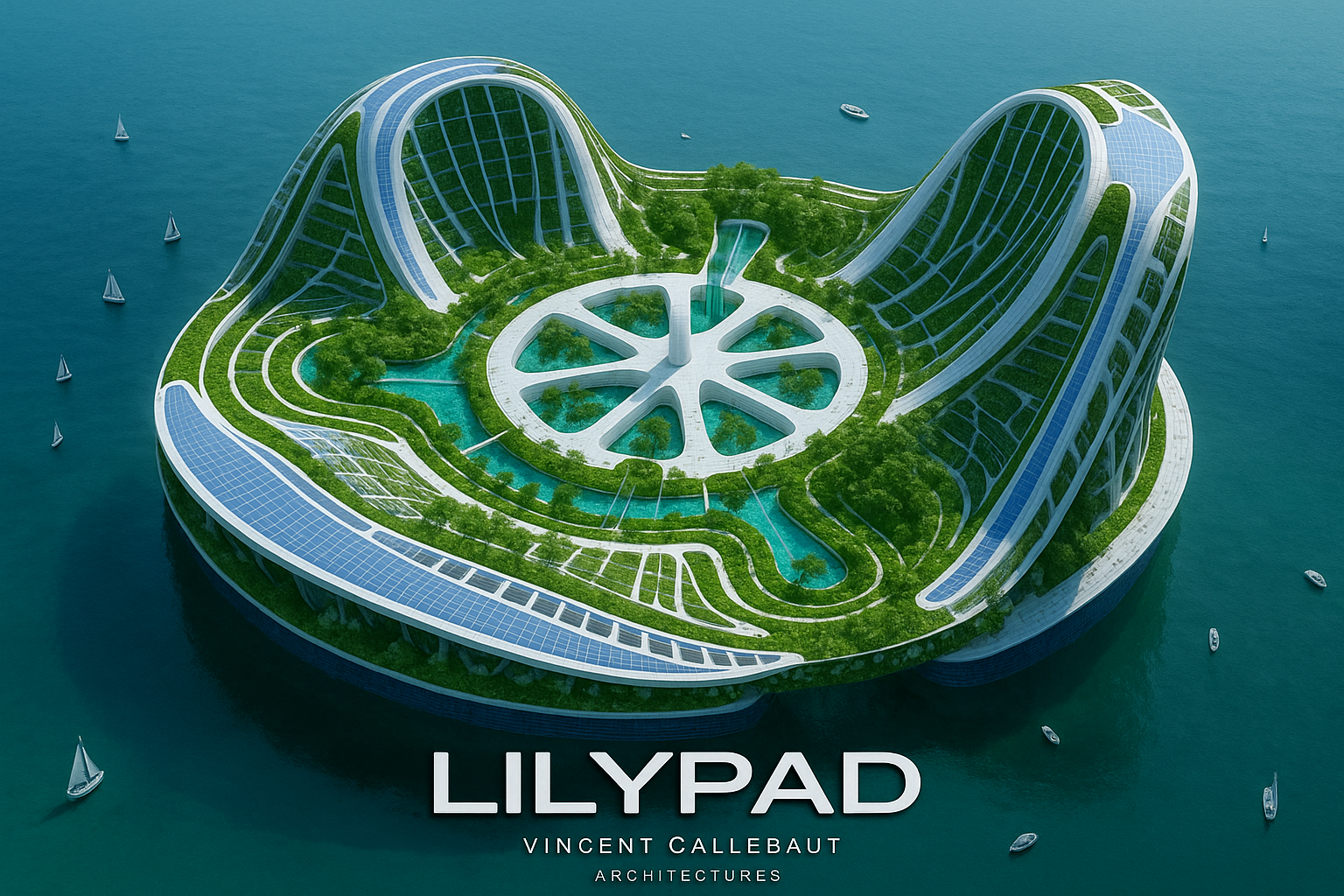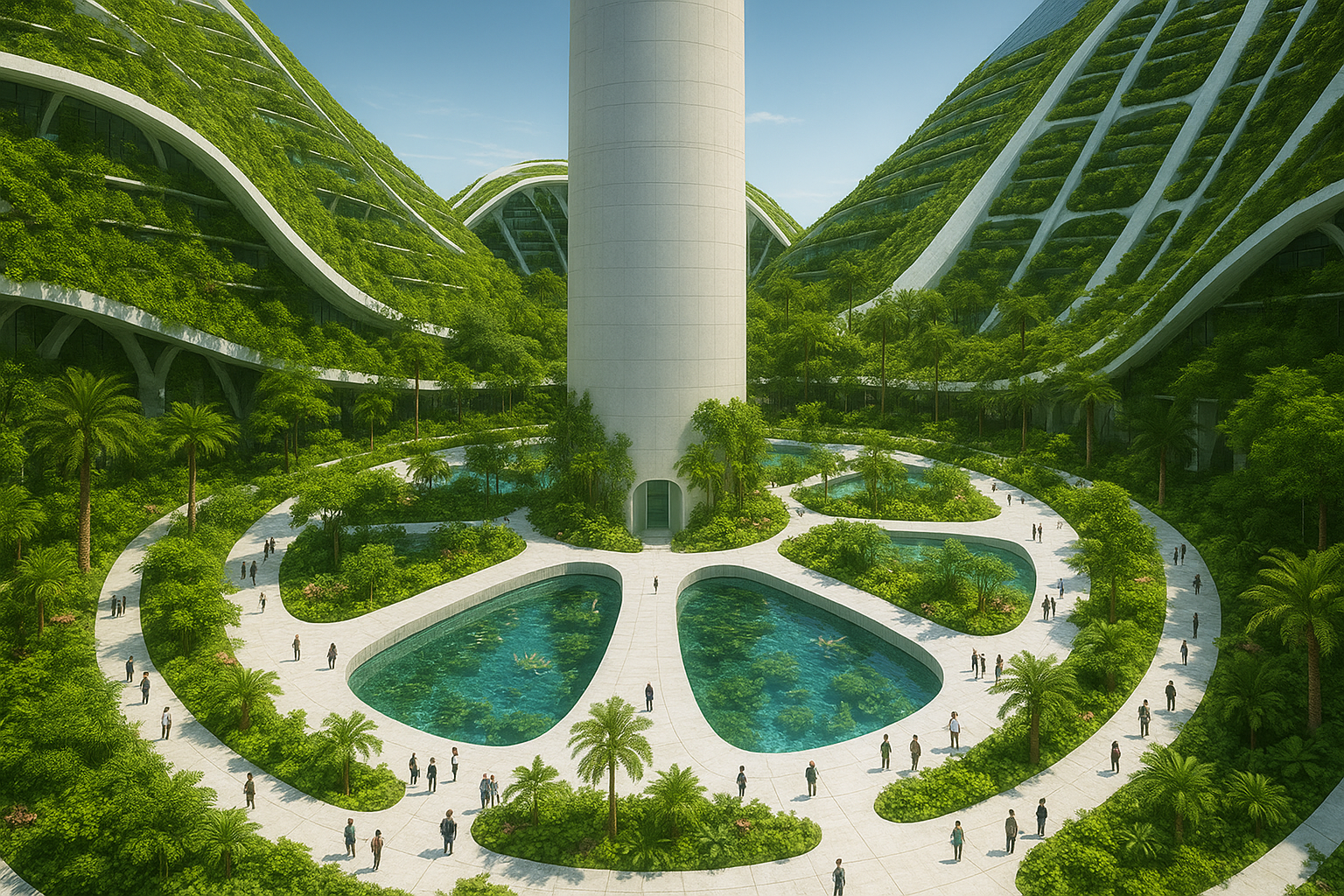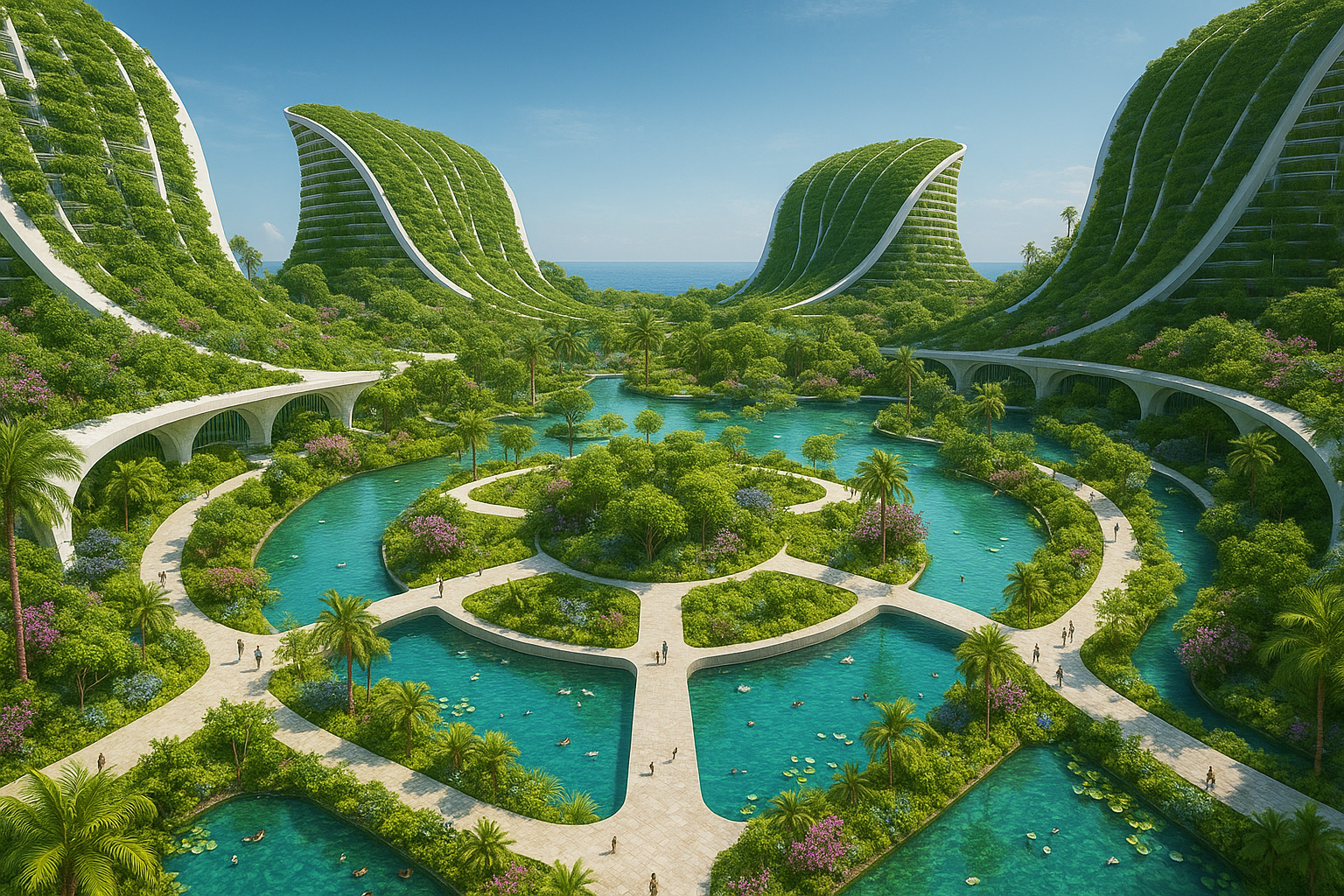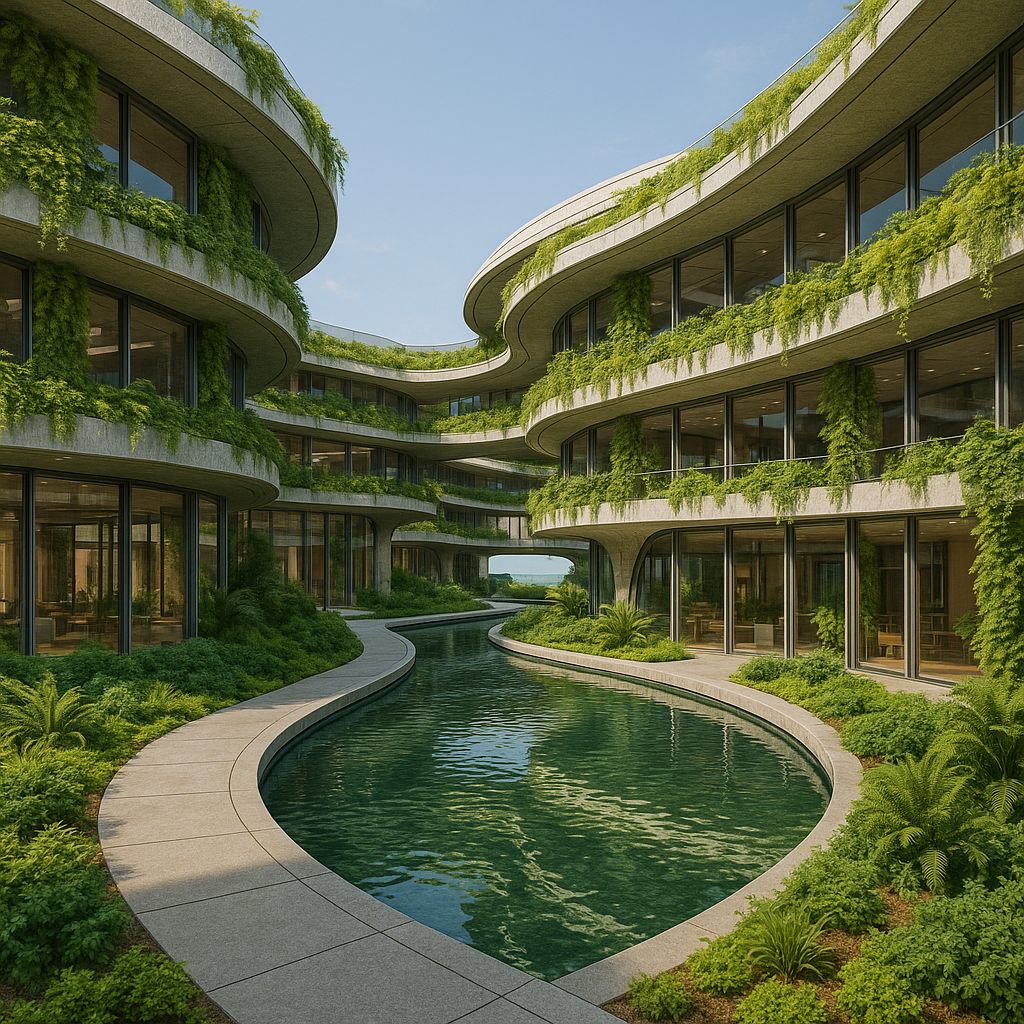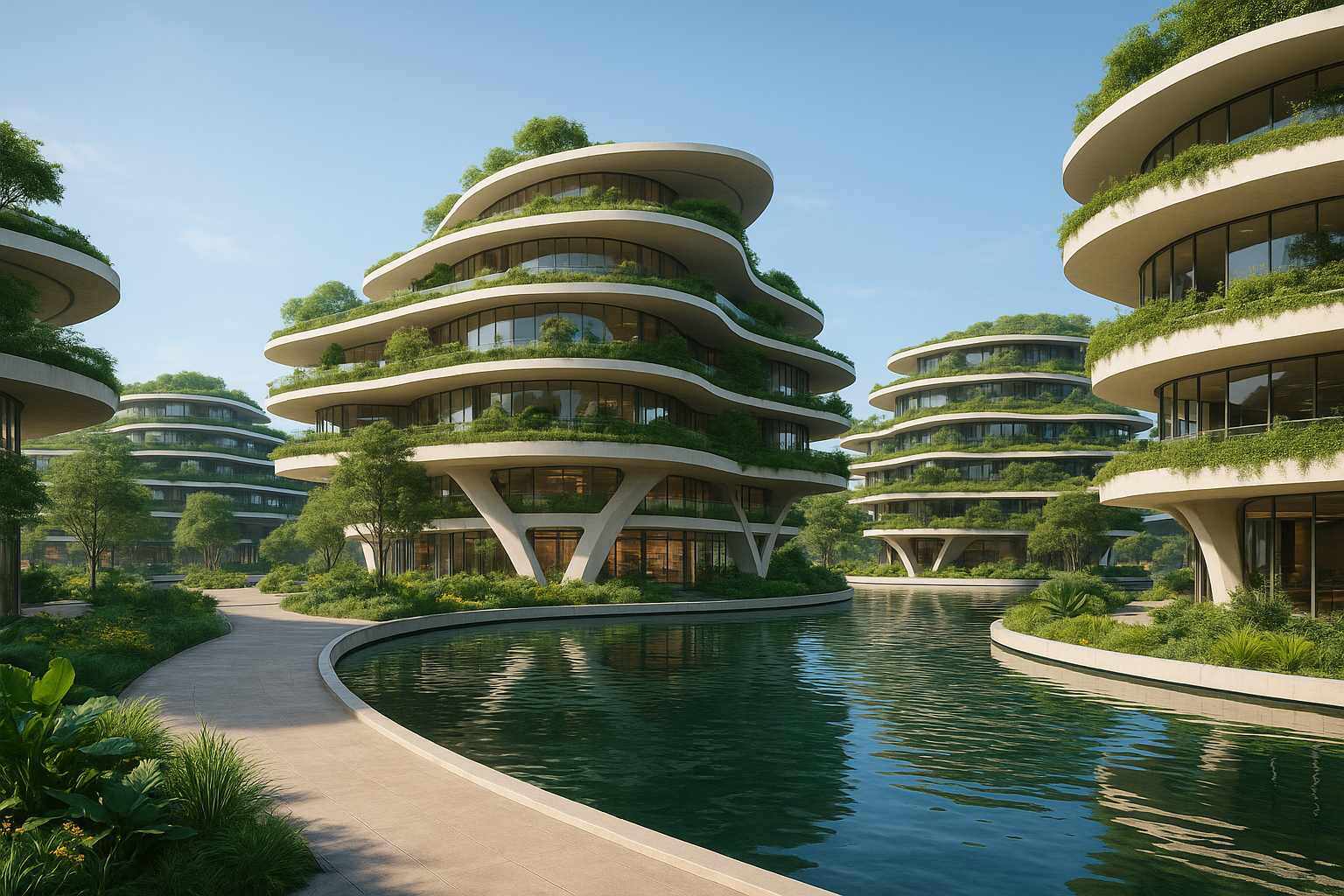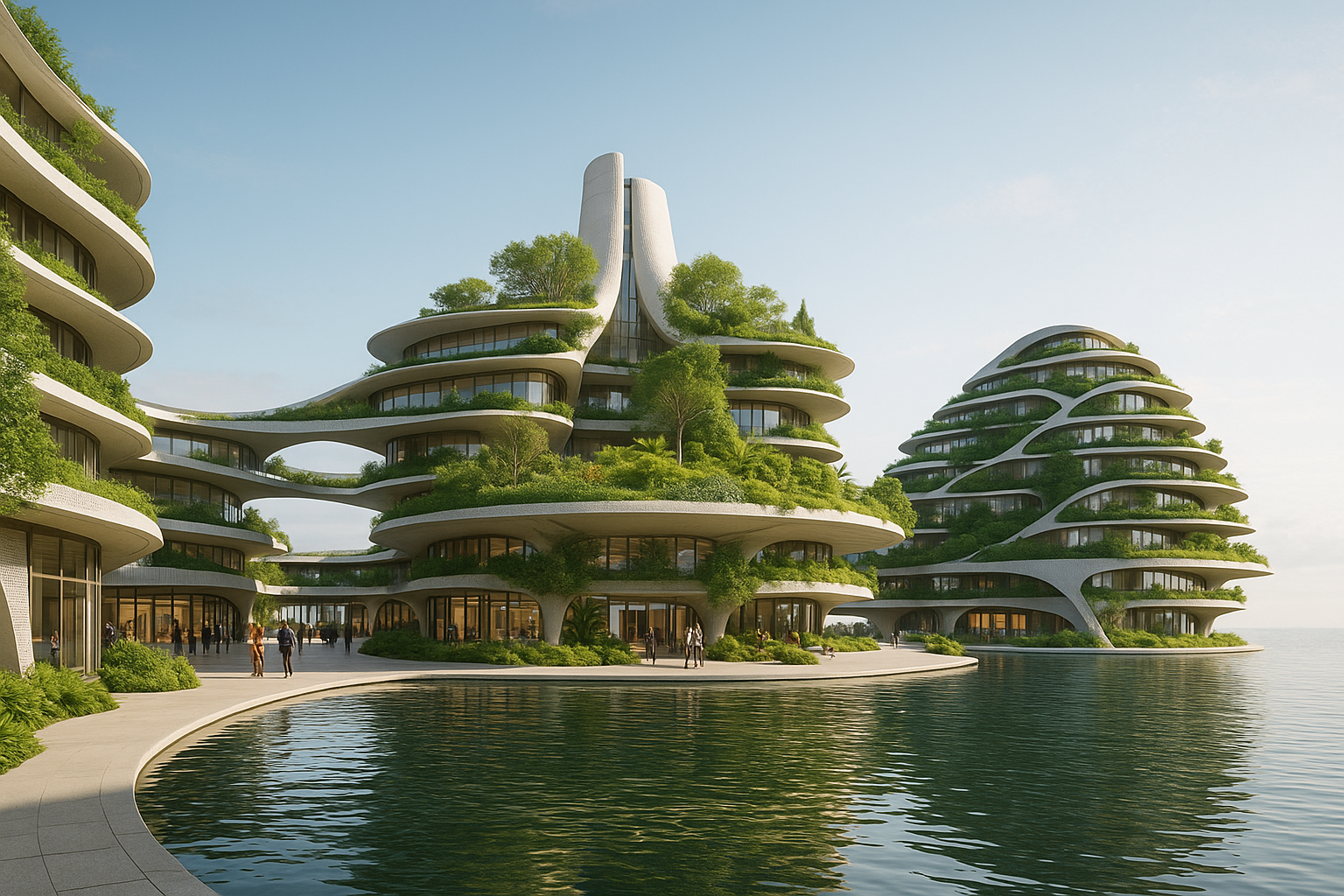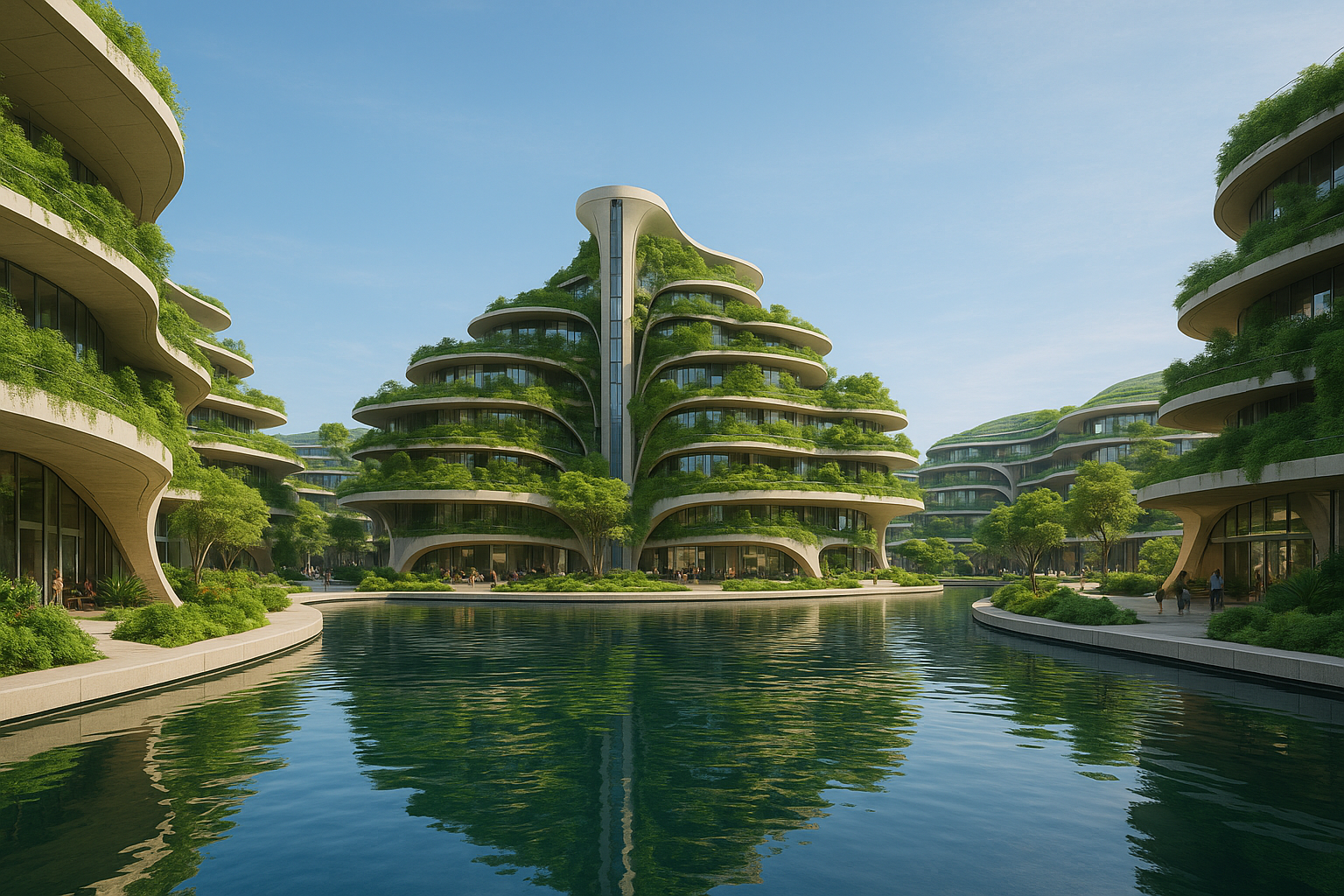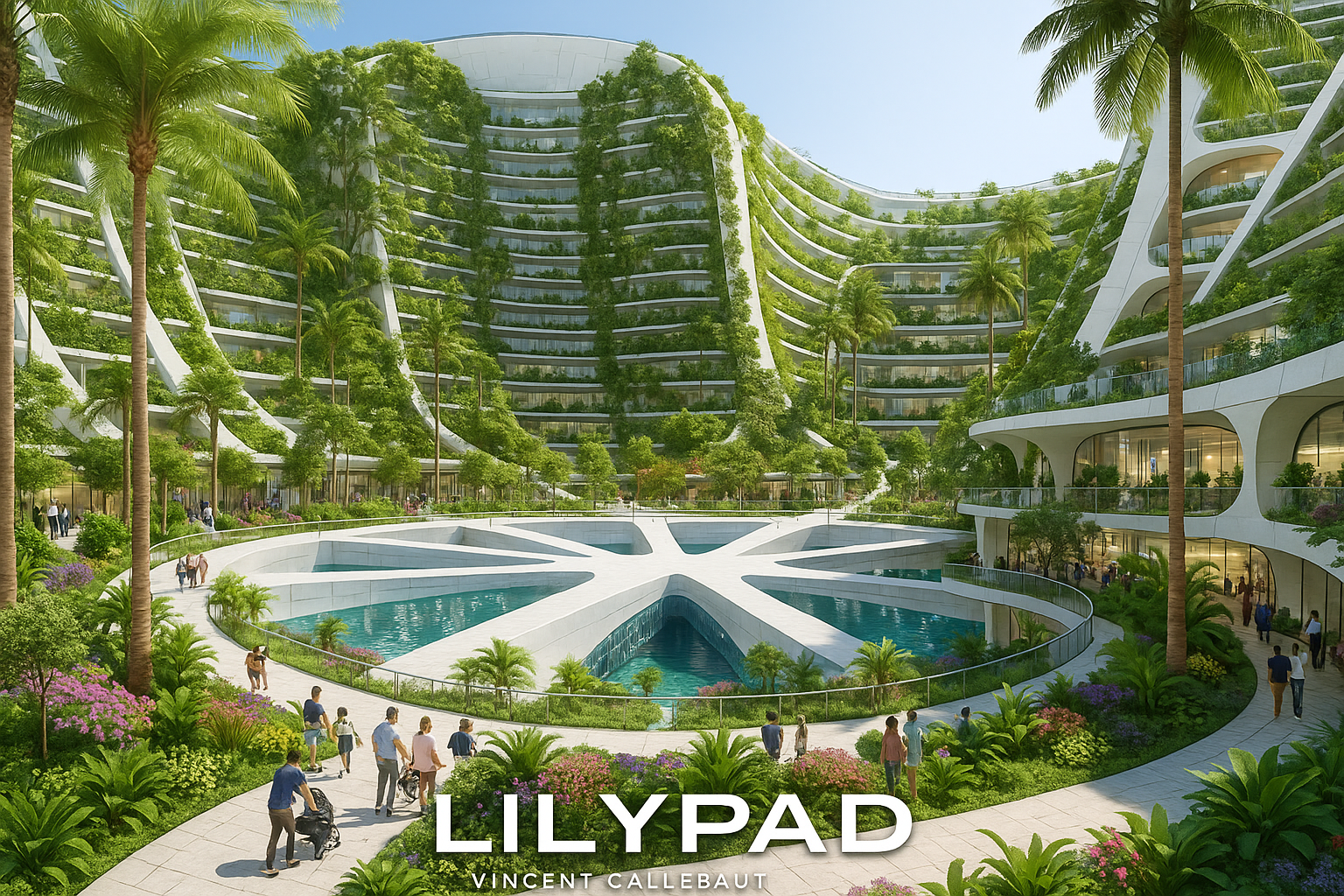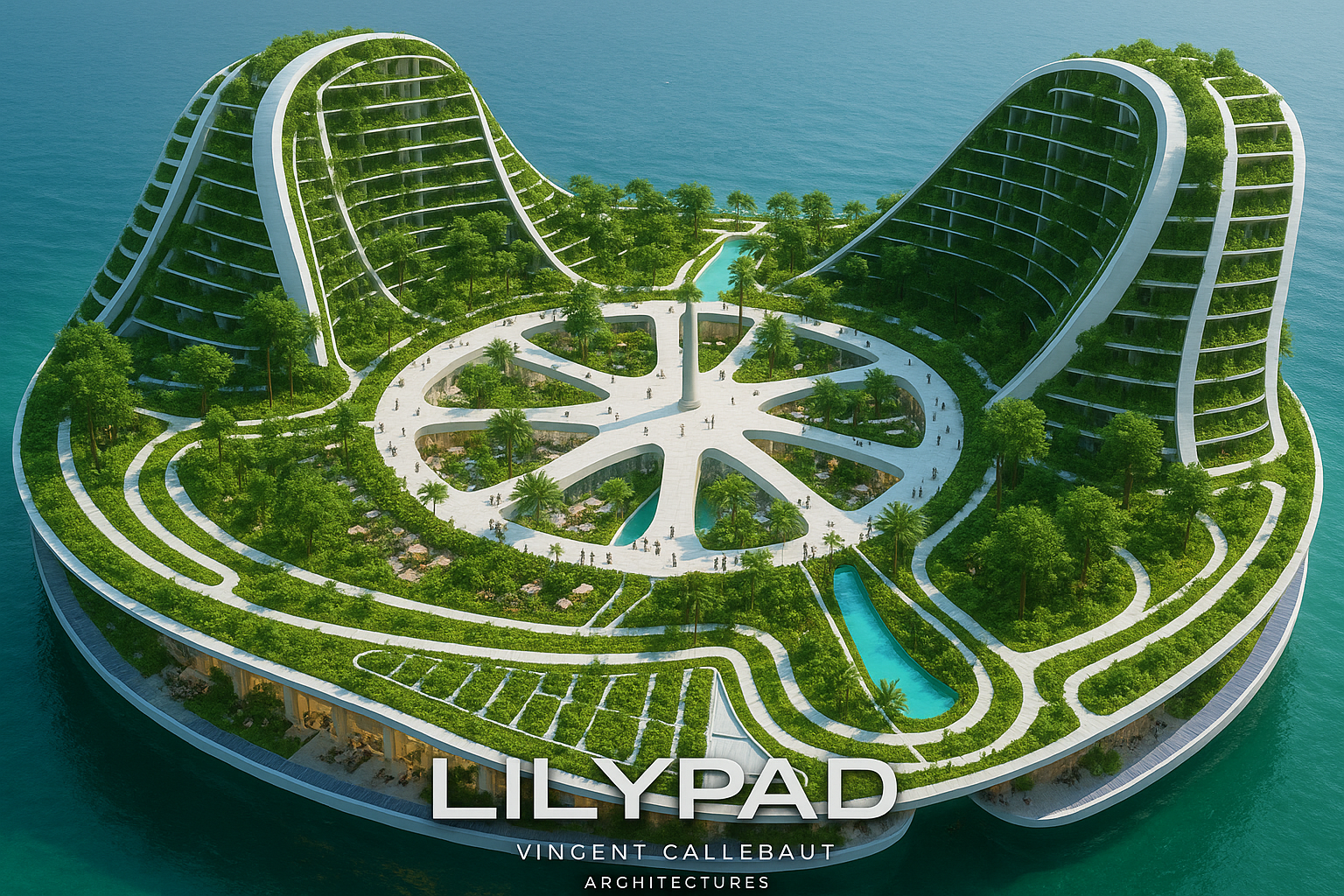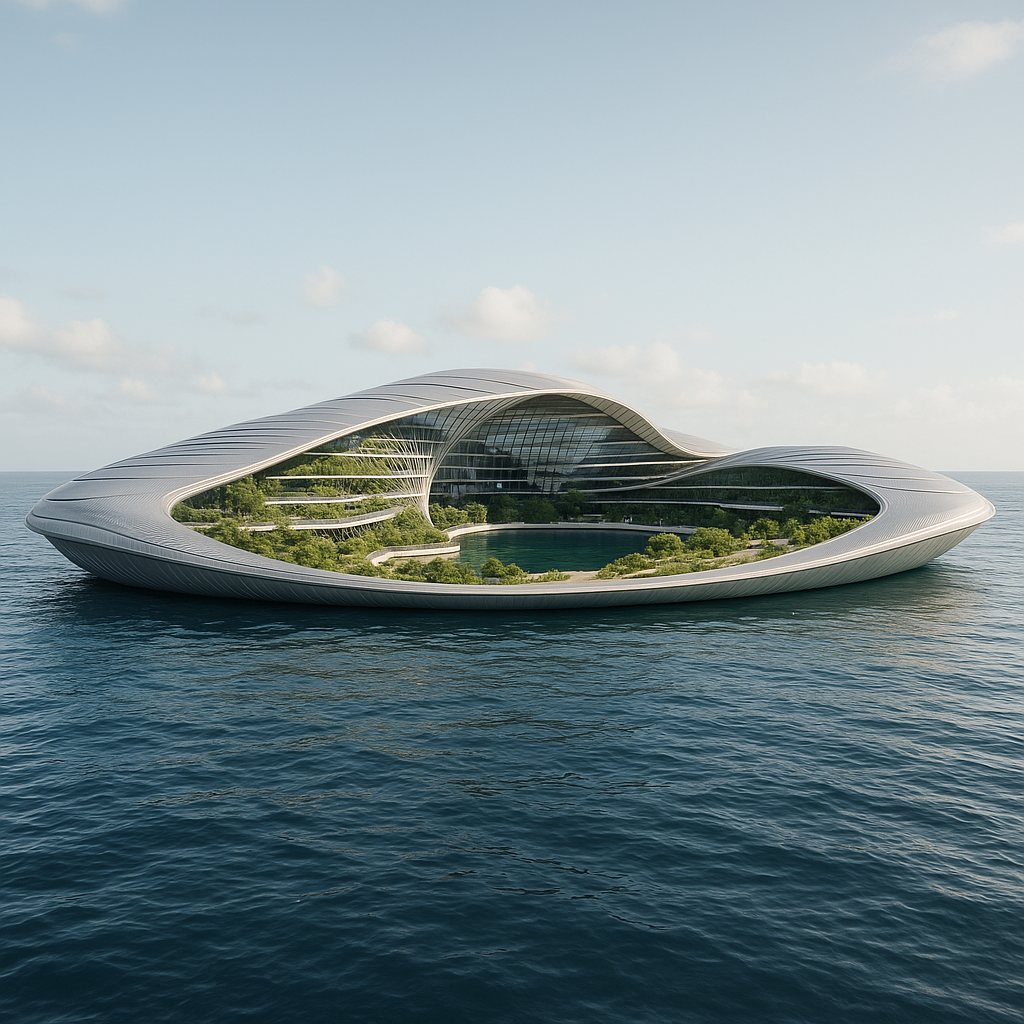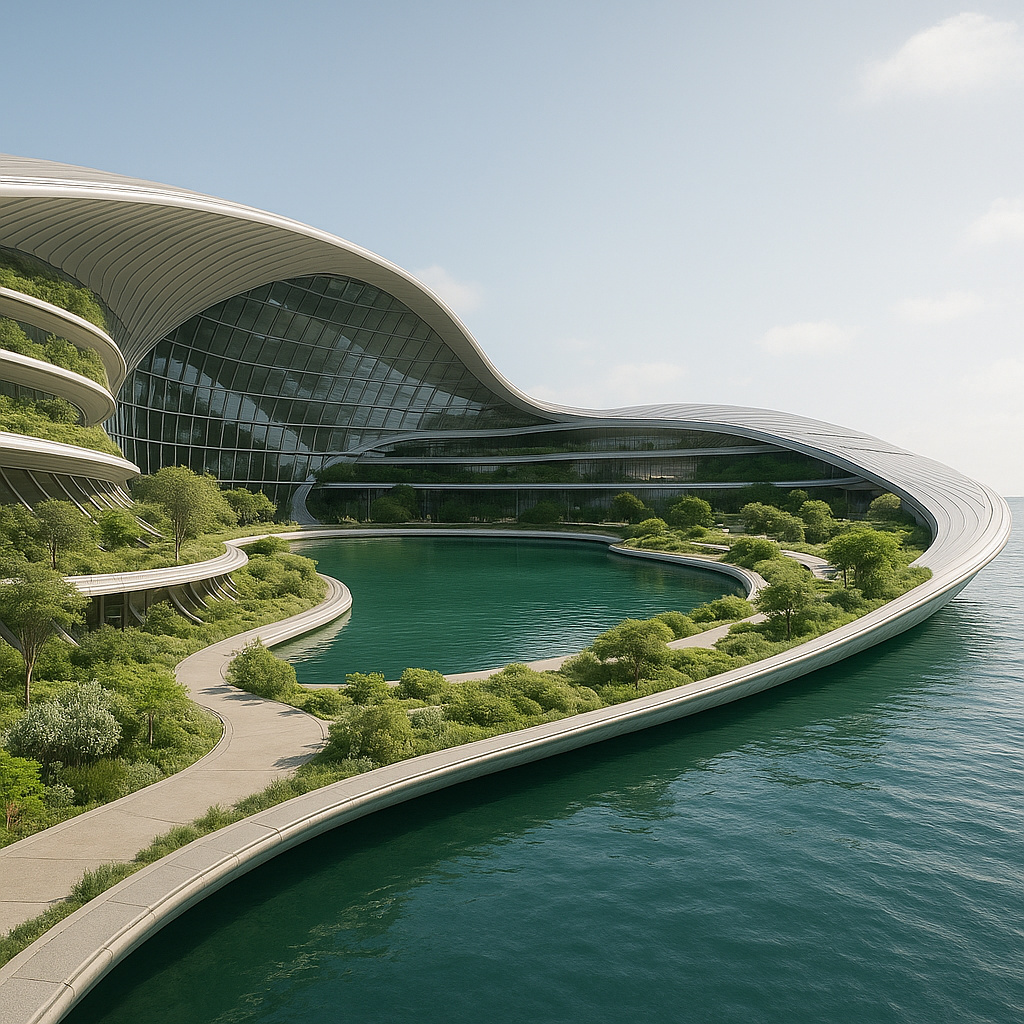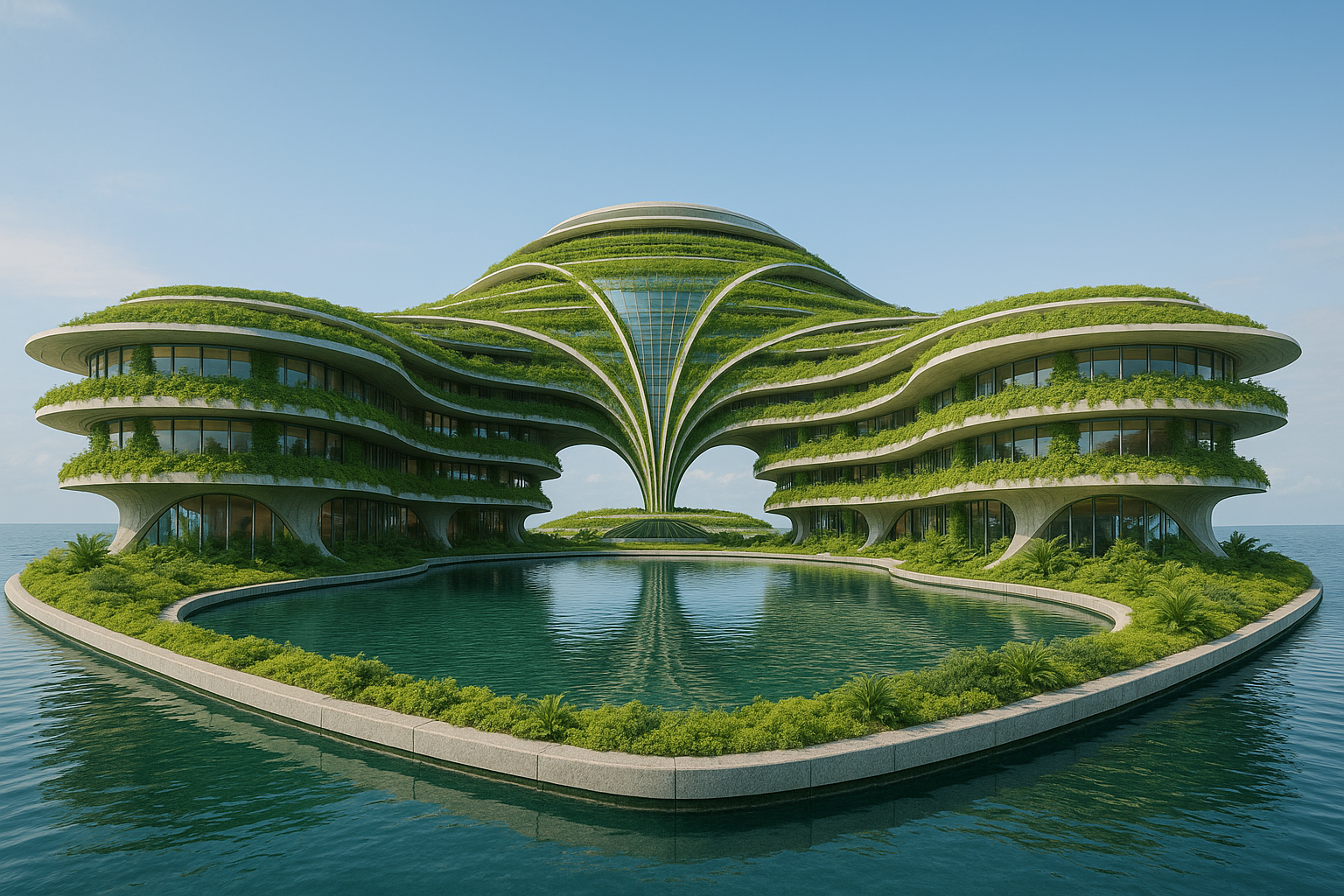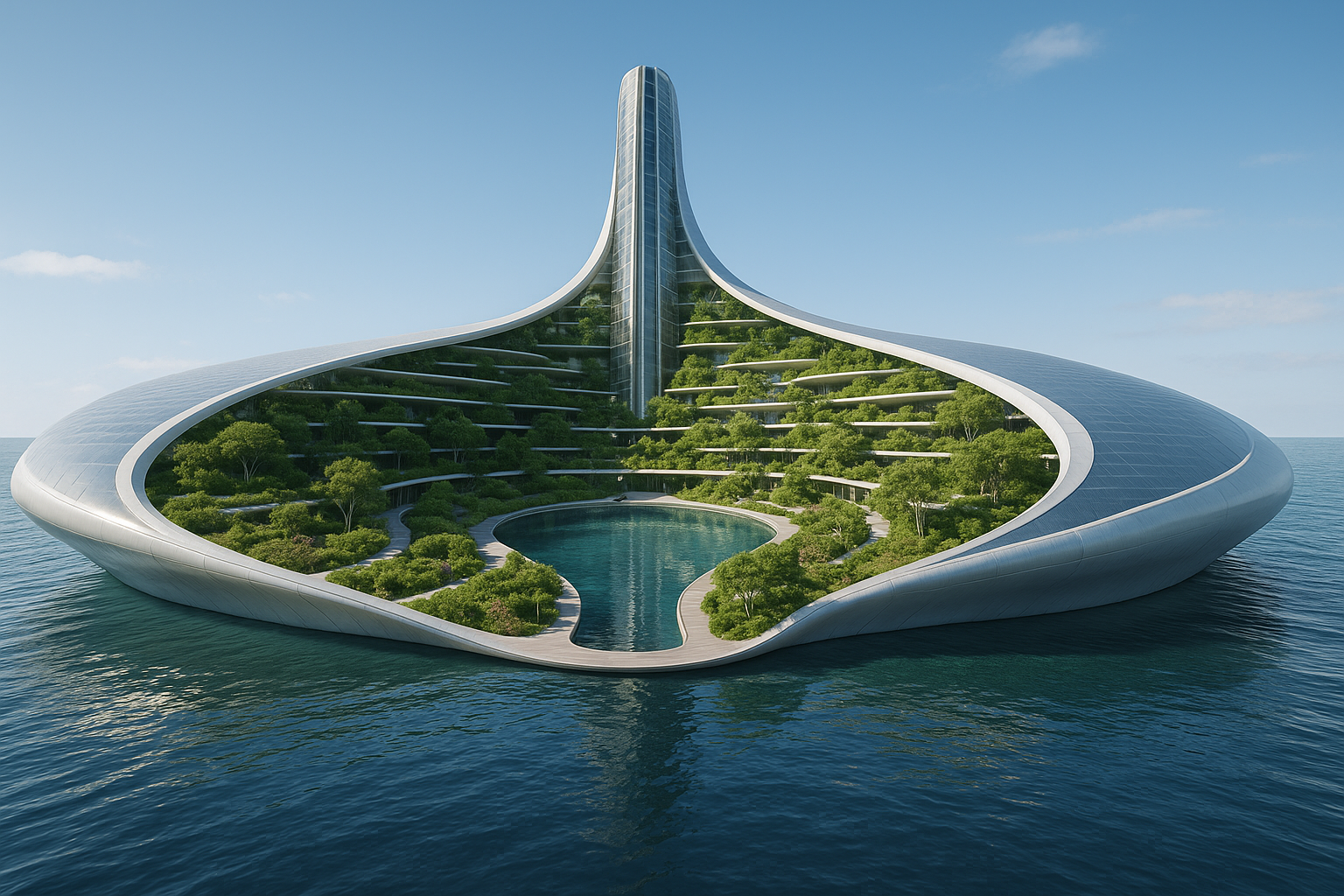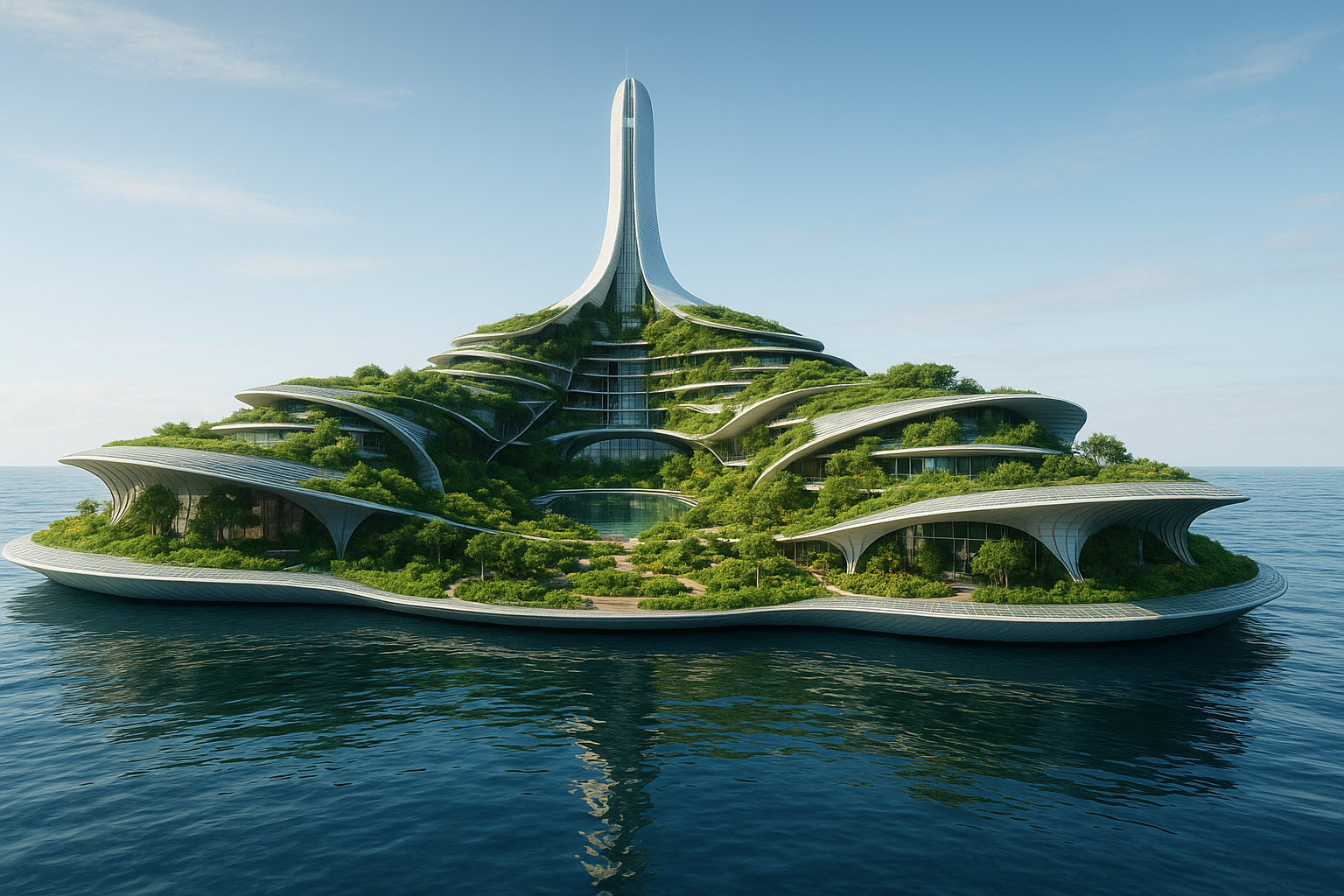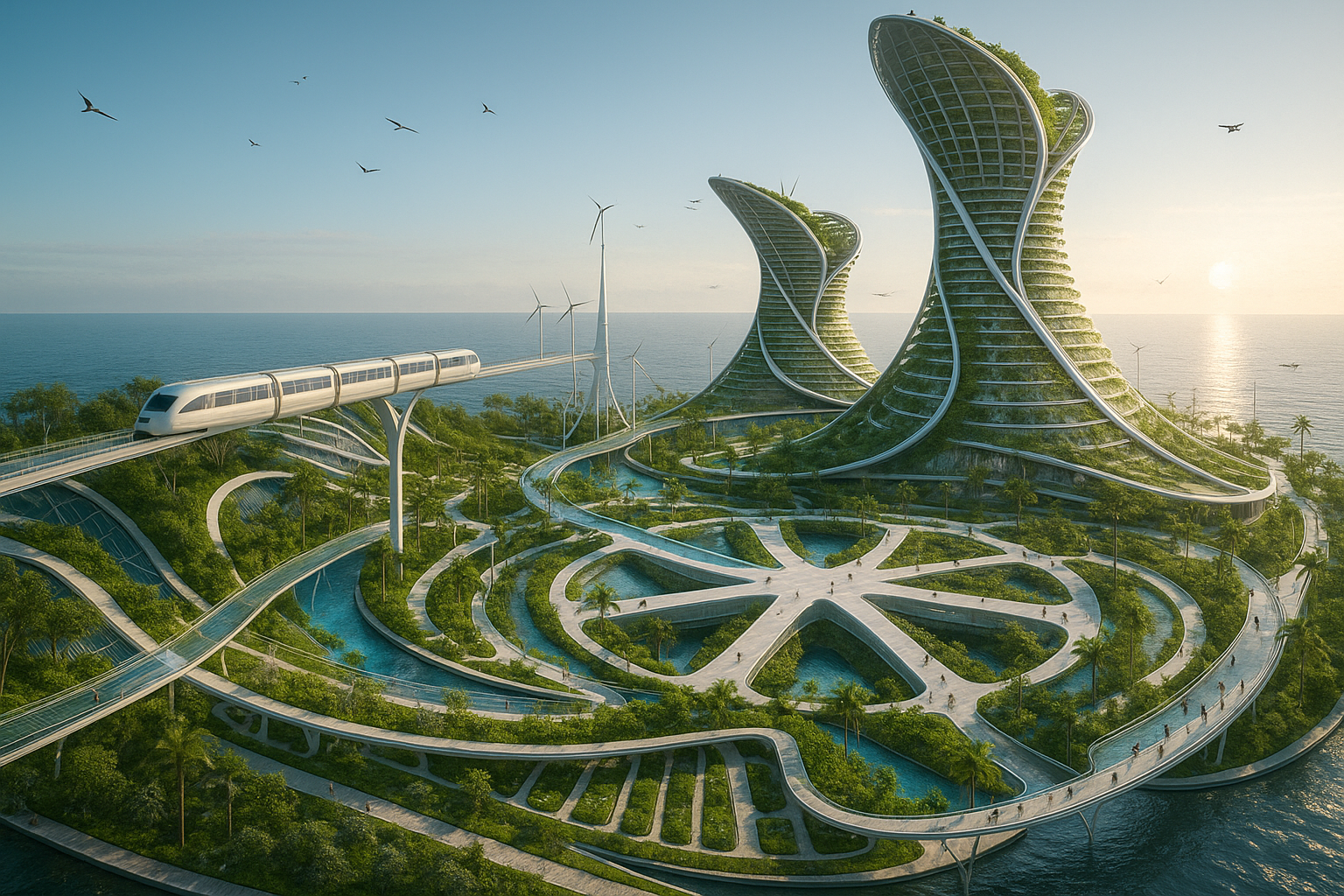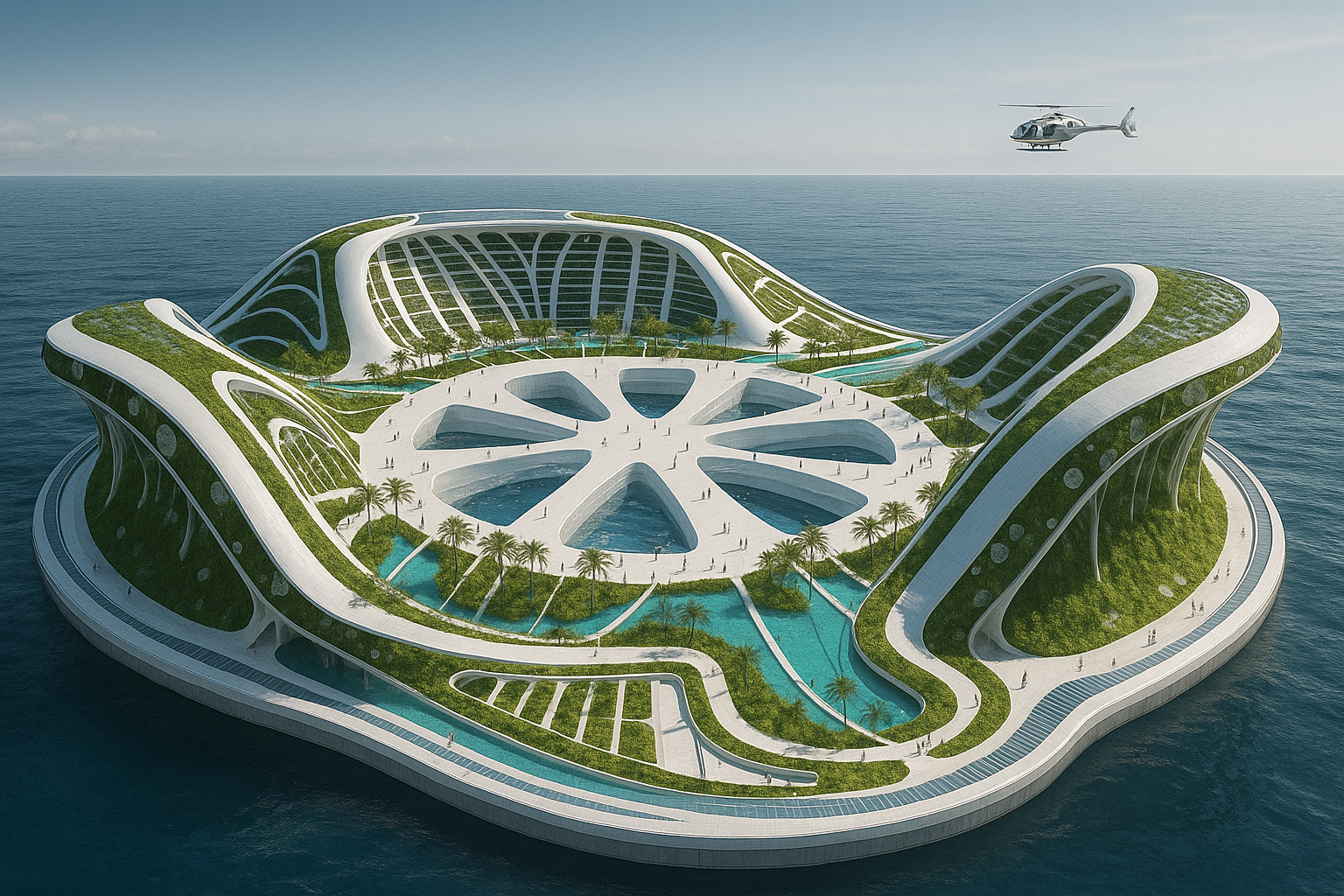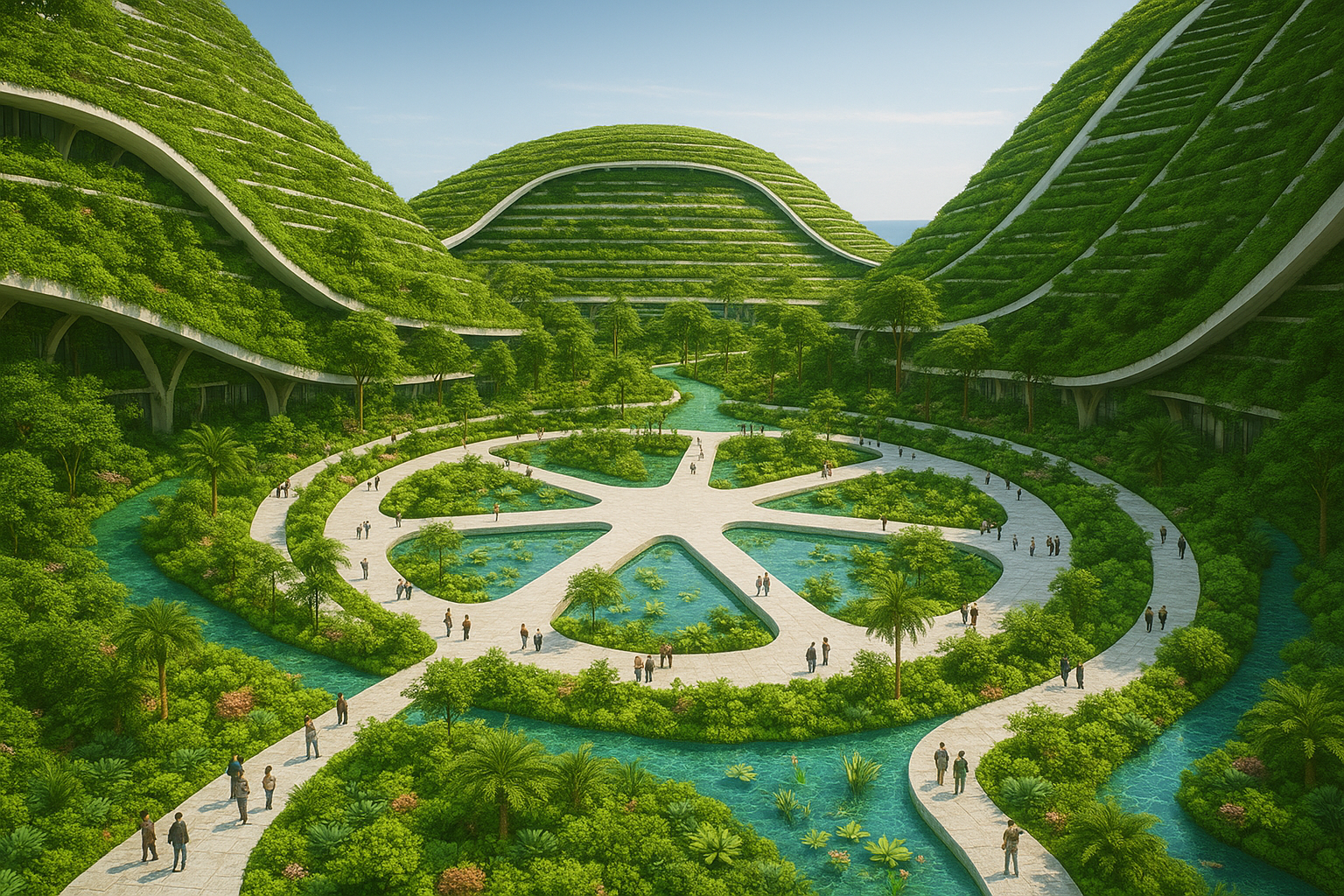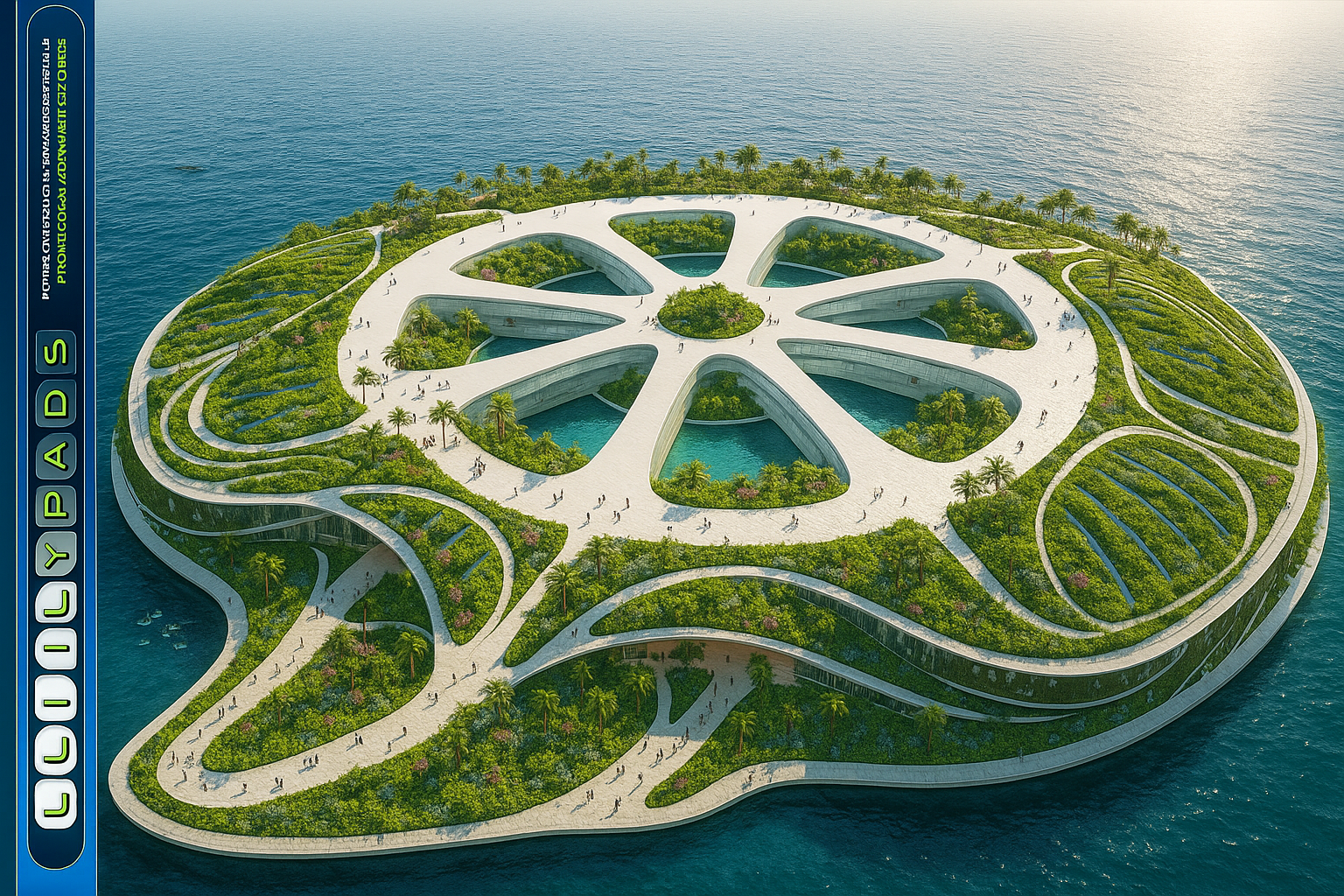Lilypad de Vincent Callebaut Architectures
Principais características
Prompt positivo: Ultra-realistic 8K architectural visualization, eye-level perspective of Lilypad, the utopian floating city envisioned by Vincent Callebaut Architectures in 2008. Designed as a self-sufficient, ocean-based habitat, the city emerges as a visionary response to rising sea levels and climate-driven displacement. Its biomimetic form floats gracefully on the water’s surface, offering sustainable refuge for future climate migrants from affected nations.
The urban concept is deeply attuned to the rhythms of nature, aligning with ecological cycles to establish a new model of regenerative and resilient urbanism. Sustainability lies at the core of Lilypad’s design — the city operates with a positive energy balance and zero carbon emissions. Its infrastructure is powered entirely by renewable energy sources, including solar, thermal, wind, hydraulic, and biomass systems, among others.
The architecture fuses futuristic innovation with environmental harmony. The floating platform is composed of lightweight, high-performance materials — carbon fiber, bioplastics, and marine-grade steel — and features integrated vegetation, aquaponic farms, and water purification systems. Rendered under natural daylight with hyper-real textures and serene oceanic reflections, the image captures Lilypad as a poetic, high-tech oasis — an emblem of hope for a sustainable urban future adrift on the sea.
Prompt negativo: low resolution, post-apocalyptic setting, dystopian imagery, dark tones, sci-fi clichés, cyberpunk aesthetic, cartoonish elements, unrealistic fantasy architecture.
Imagens produzidas pelo Chat GPT a partir de entradas de texto
Características formais
Prompt positivo: Ultra-realistic 8K architectural visualization, eye-level perspective of Lilypad, the utopian floating city envisioned by Vincent Callebaut Architectures in 2008. The city is circular in form, its internal layout organically structured, echoing the natural geometry of the Victoria amazonica water lily. This biomimetic megastructure floats in the heart of the ocean, conceived as a self-sufficient, mobile habitat that drifts across international waters.
The central element of the city is a lagoon, designed to collect rainwater and nurture its own aquatic ecosystem — a living core that sustains biodiversity. The circular structure features gently undulating height variations, giving it a dynamic, organic profile. The megastructure is modular and repeatable, allowing for the expansion of Lilypad units according to a unified master plan.
The outer skin of the structure is composed of a dual-layer membrane made from polyester fibers coated with titanium dioxide. This skin, reacting to ultraviolet rays, triggers a photocatalytic process that absorbs atmospheric pollution — transforming the city into an active environmental purifier.
Constructed with futuristic materials and marine engineering precision, the city integrates renewable energy sources, climate-responsive systems, and ecological design. Captured under natural daylight with hyper-realistic textures — rippling water reflections, high-performance composite surfaces, and integrated greenery — the image conveys a serene, floating metropolis in harmony with its environment and in constant motion across the oceanic expanse.
Prompt negativo: Low resolution, fantasy-style islands, post-apocalyptic settings, dystopian tone, neon lighting, cyberpunk or anime aesthetic, exaggerated sci-fi structures, cartoonish rendering.
Imagens produzidas pelo Chat GPT a partir de entradas de texto
Características de Infraestrutura de Mobilidade
Prompt positivo: Ultra-realistic 8K architectural visualization, eye-level perspective of Lilypad, the utopian floating city envisioned by Vincent Callebaut Architectures in 2008. At the heart of the structure lies a central column — the primary connective core — responsible for the vertical distribution of goods and resources through a network of advanced elevators. This infrastructural spine anchors the entire city, enabling efficient, layered circulation across its floating form.
Spatial organization within Lilypad reflects a thoughtful separation of uses: distinct zones are allocated for humans, plants, and animals, ensuring ecological harmony and functional clarity. Dedicated routes define entry and exit points, streamlining movement across public, private, and technical spaces within the megastructure.
The city itself floats as a circular, self-sustaining ecosystem inspired by the Victoria water lily, equipped with advanced environmental systems and constructed from high-performance materials. Rendered in natural daylight, the image highlights the intricacy of vertical logistics, the modular fluidity of its internal circulation, and the calm clarity of its sustainable oceanic environment — a visionary fusion of biological logic and futuristic urbanism.
Prompt negativo: low resolution, sci-fi dystopia, cyberpunk glow, cartoonish or fantasy aesthetics, cluttered interiors, unrealistic proportions, exaggerated tech, game-style rendering.
Imagens produzidas pelo Chat GPT a partir de entradas de texto
Características dos Espaços Verdes
Prompt positivo: Ultra-realistic 8K architectural visualization, eye-level perspective of Lilypad, the utopian floating city envisioned by Vincent Callebaut Architectures in 2008. Designed as a self-sustaining marine ecosystem, Lilypad supports an extensive range of biodiversity, nurturing its own distinct flora and fauna. The city floats serenely atop the ocean, combining visionary architecture with ecological harmony.
At its core lies a central lagoon — a living, functional element that collects rainwater and sustains plant life throughout the structure. This internal body of water acts as both an environmental reservoir and a catalyst for continuous botanical growth, reinforcing the city’s symbiotic relationship with nature.
The architecture merges biophilic design with advanced engineering, incorporating organically curved forms, vertical gardens, and habitat zones that foster ecological diversity. Rendered in natural daylight with ultra-realistic textures — glistening water surfaces, dense vegetation, and composite eco-materials — the image captures Lilypad as a floating sanctuary, thriving with life and shaped by the principles of sustainable urbanism.
Prompt negativo: low resolution, dystopian style, futuristic clutter, sci-fi elements, dark tones, fantasy islands, cartoon aesthetics, cyberpunk glow, artificial vegetation.
Imagens produzidas pelo Chat GPT a partir de entradas de texto
Características Espaciais e Funcionais
Prompt positivo: Ultra-realistic 8K architectural visualization, eye-level perspective of Lilypad, the utopian floating city envisioned by Vincent Callebaut Architectures in 2008. The city’s architecture features multifunctional buildings that seamlessly integrate workspaces, retail areas, and leisure facilities — fostering community interaction and spatial fluidity through vibrant collective zones.
Public spaces are designed to promote social engagement and shared experiences, emphasizing openness and coexistence. Housing units are thoughtfully dispersed throughout the structure, blending into the overall urban form with integrated green rooftops and suspended gardens. These vegetated elements soften the built environment and reinforce Lilypad’s ecological identity.
The design encourages a deep connection between inhabitants and nature, aiming to create a harmonious lifestyle within a floating, self-sufficient ecosystem. Captured under natural daylight with ultra-detailed textures — living facades, biophilic materials, and reflective aquatic surroundings — the image reveals a lush, elevated urban habitat rooted in sustainability and collective well-being.
Prompt negativo: low resolution, dystopian aesthetics, sci-fi fantasy, exaggerated tech elements, cartoon visuals, dark lighting, empty or lifeless spaces, game-style architecture.
Imagens produzidas pelo Chat GPT a partir de entradas de texto
Todos os prompts anteriores.
Prompt positivo: Ultra-realistic 8K architectural visualization, eye-level perspective of Lilypad, the utopian floating city envisioned by Vincent Callebaut Architectures in 2008. This marine-based, self-sufficient habitat emerges as a poetic and high-tech response to rising sea levels and climate-induced displacement. Its biomimetic form, inspired by the Victoria amazonica water lily, gently floats on the ocean’s surface — a serene, circular megastructure designed to host future climate migrants from submerged nations.
Conceived as a regenerative and resilient urban ecosystem, Lilypad embodies a symbiosis between technological innovation and ecological harmony. At its core lies a central lagoon — a living reservoir that collects rainwater and sustains aquatic biodiversity. The city’s undulating profile rises and falls with graceful rhythm, echoing natural geometry. Modular and scalable, each unit can be replicated to form an archipelago of mobile cities adrift in international waters.
A double-layered outer membrane, crafted from UV-reactive polyester coated in titanium dioxide, triggers a photocatalytic process that absorbs atmospheric pollution, turning the entire structure into an active environmental purifier. Its infrastructure — composed of marine-grade steel, carbon fiber, and bioplastics — integrates aquaponic farms, water purification systems, and advanced vertical logistics centered around a spine-like core equipped with intelligent elevators for efficient internal circulation.
The spatial organization follows a layered ecology of function and habitat. Zones are delicately partitioned for humans, flora, and fauna, maintaining a holistic balance. Floating public plazas, green-roofed housing, suspended gardens, and multifunctional pavilions intertwine within the structure, promoting vibrant communal life and seamless spatial transitions. Powered entirely by renewable energy — including solar, wind, tidal, thermal, and biomass systems — Lilypad maintains a positive energy balance and net-zero carbon footprint.
Rendered in natural daylight with hyper-realistic textures, the image captures shimmering aquatic reflections, tactile architectural surfaces, and lush, integrated vegetation. The atmosphere evokes a floating sanctuary — a visionary blueprint for oceanic urbanism where environmental stewardship and futuristic living merge into a fluid, drifting oasis.
Prompt negativo: low resolution, futuristic sci-fi cities, glass skyscrapers, cyberpunk aesthetic, neon lights, metallic surfaces, post-apocalyptic elements, dystopian atmosphere, urban decay, brutalist architecture, chaotic or fragmented layouts, foggy or unclear lighting, artificial materials, absence of natural elements, static imagery, unrealistic water reflections, fantasy style, comic-book or anime influence, exaggerated proportions, flat lighting, dull textures.
Imagens produzidas pelo Chat GPT a partir de entradas de texto
